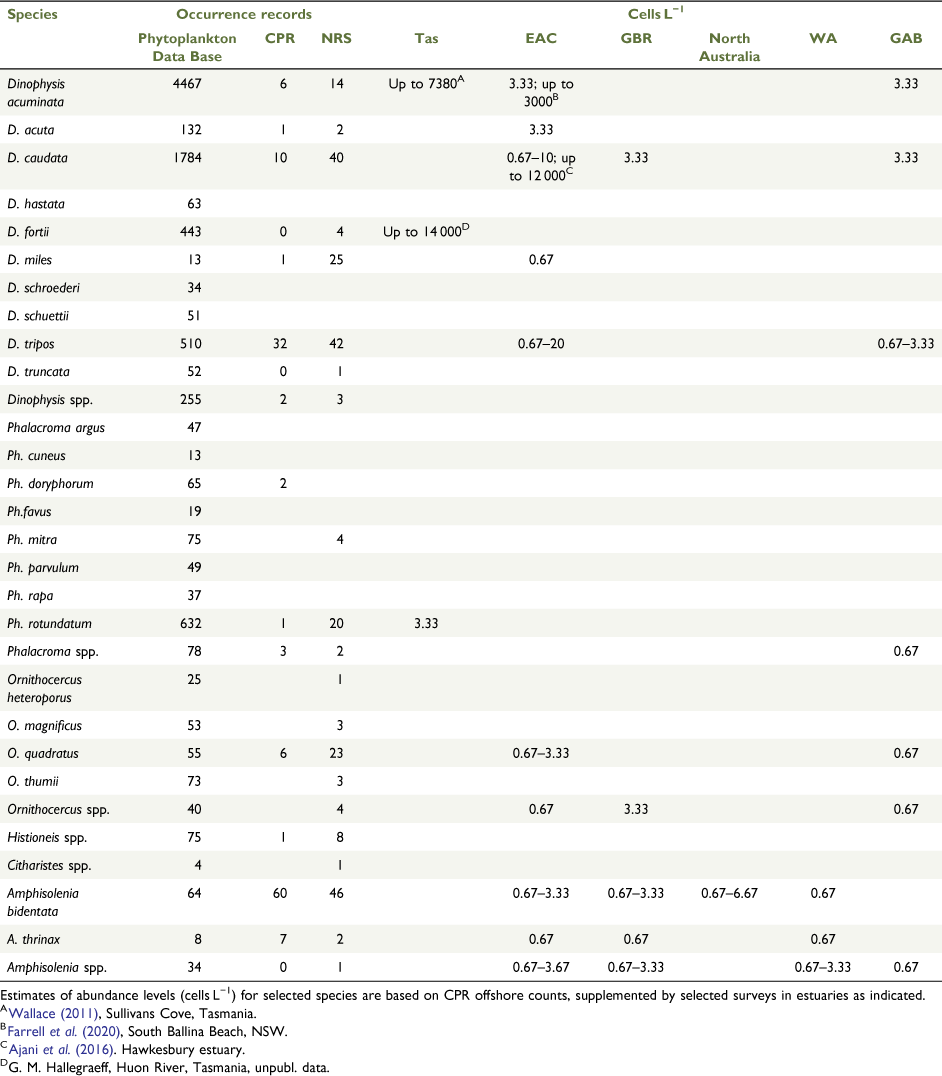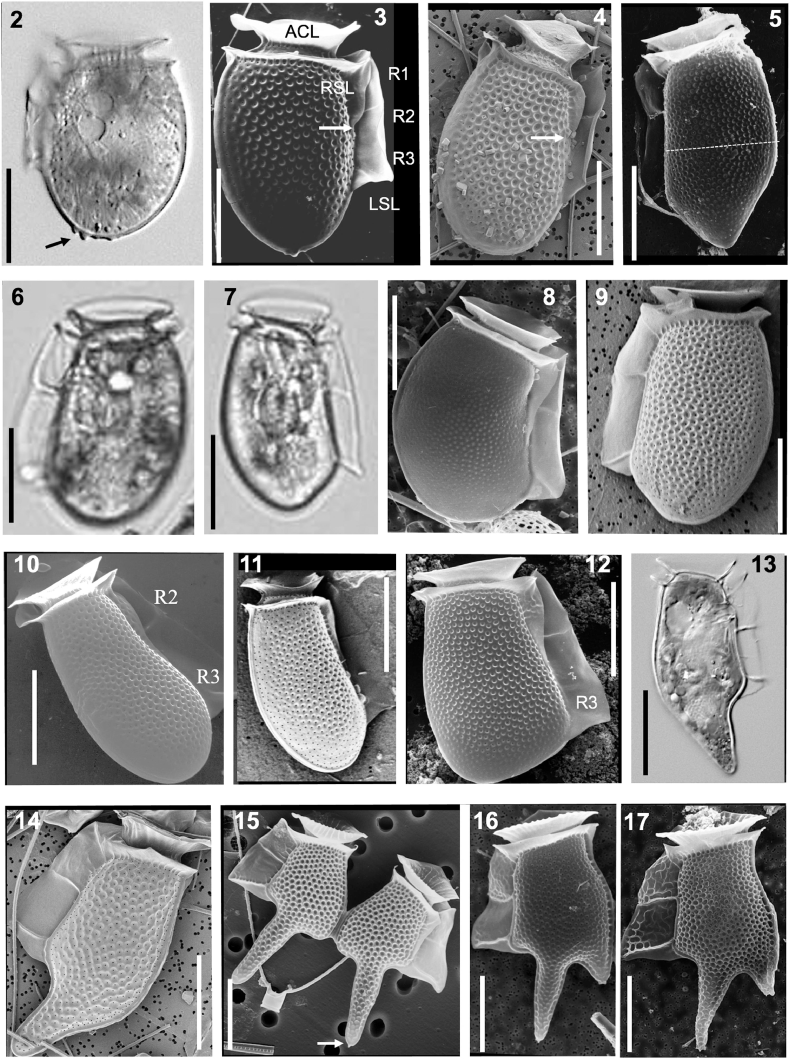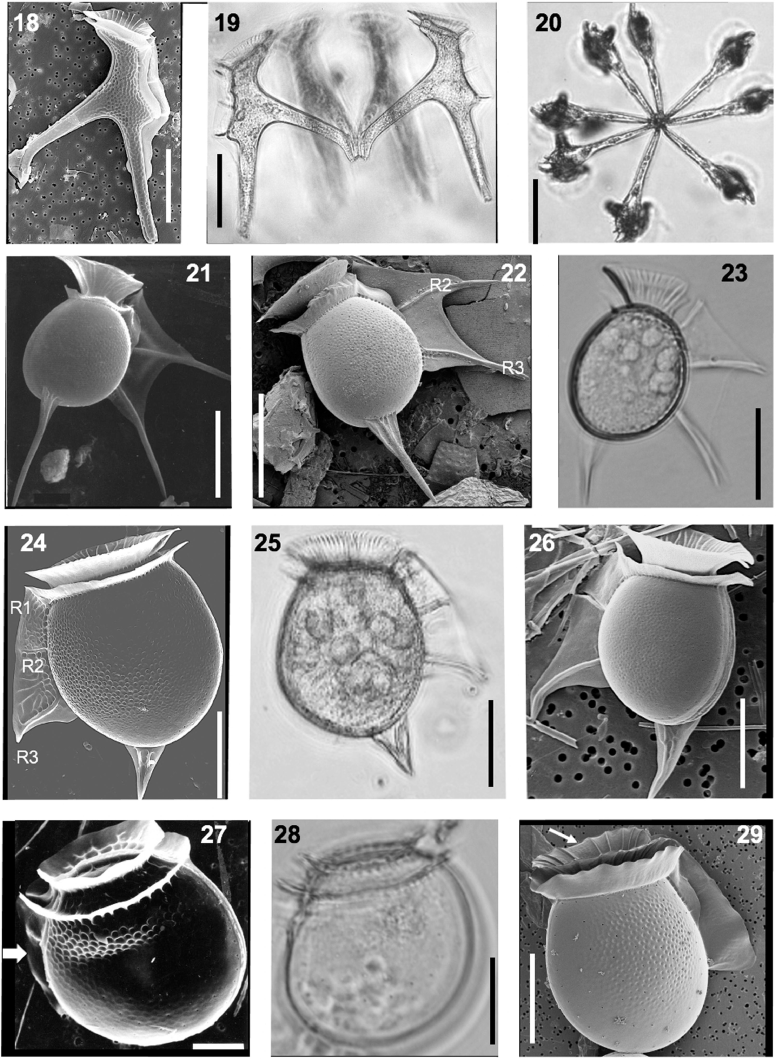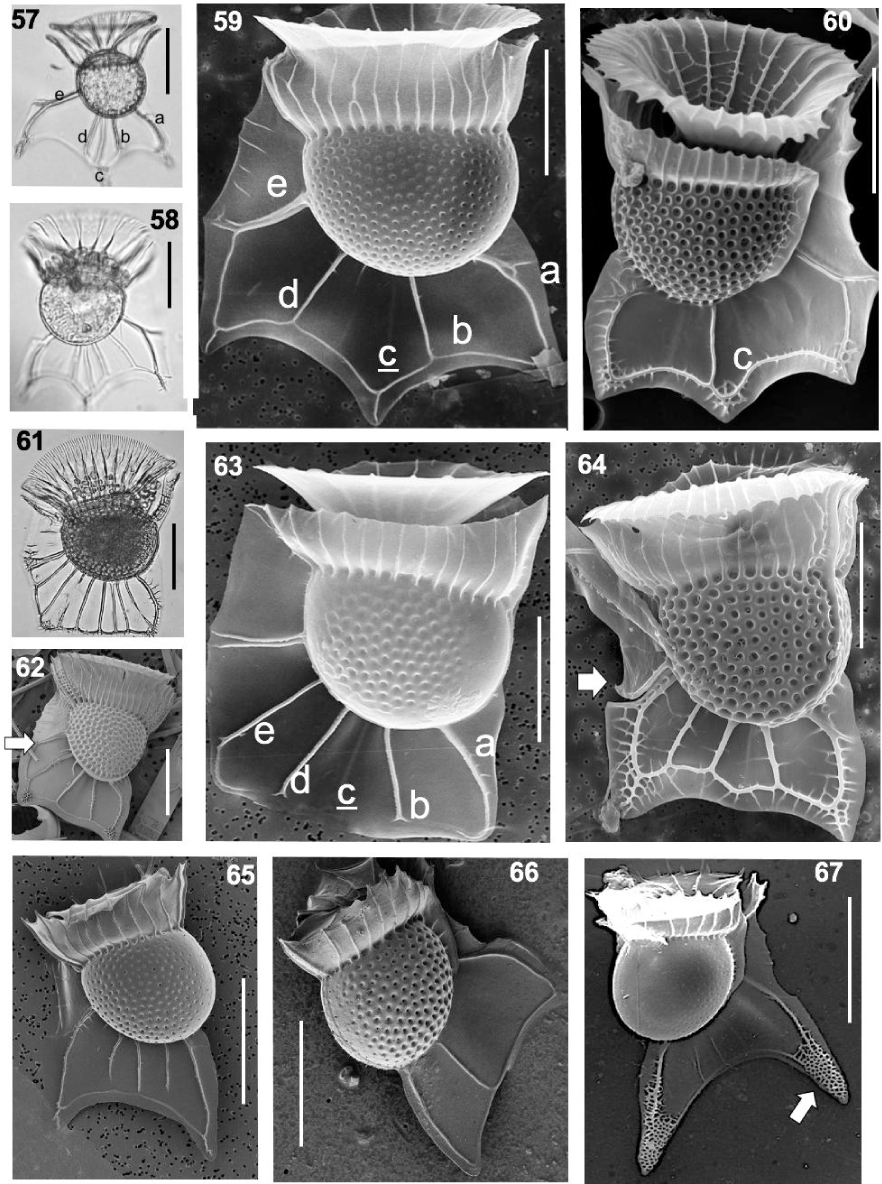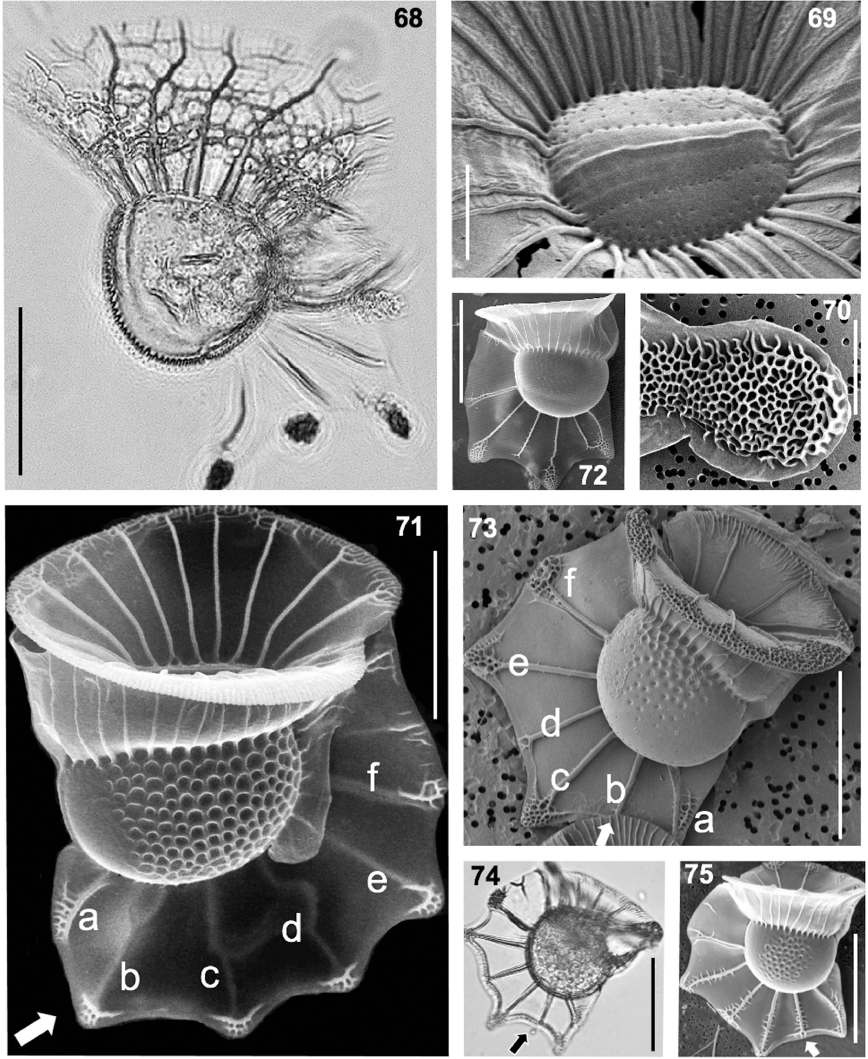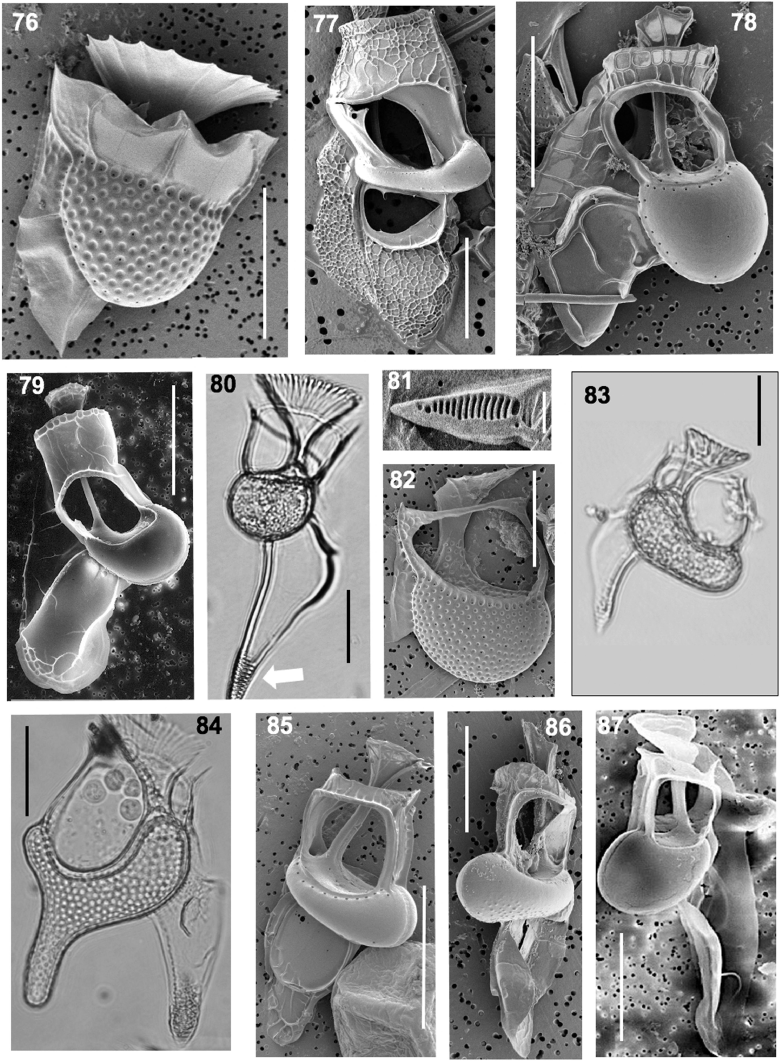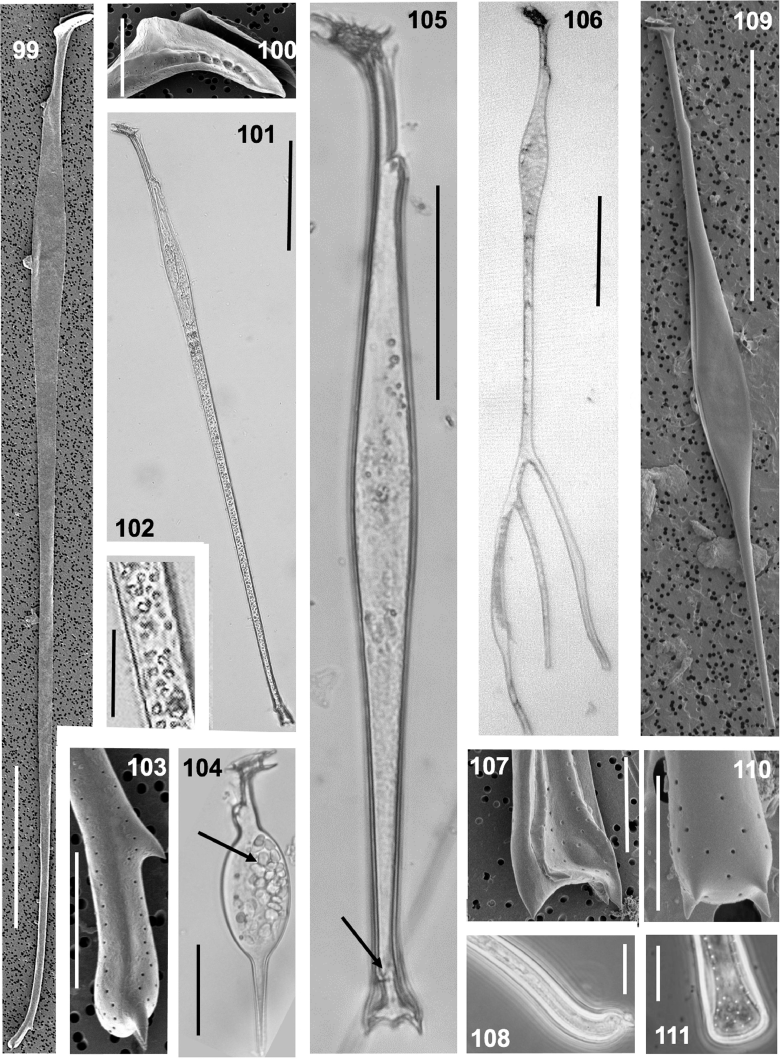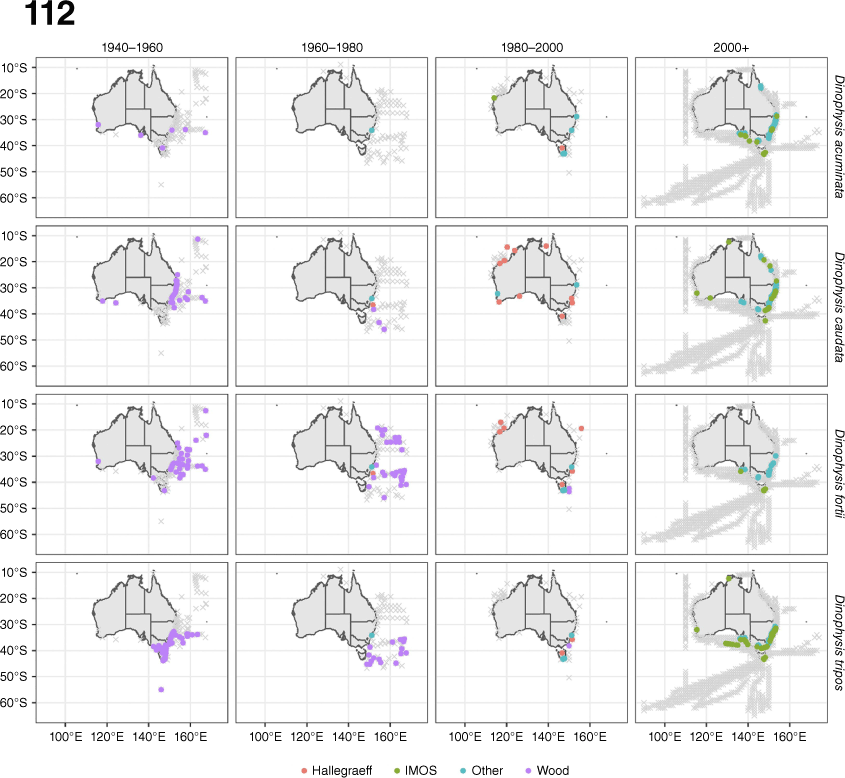Marine planktonic dinophysoid dinoflagellates (order Dinophysales): 60 years of species-level distributions in Australian waters
Gustaaf M. Hallegraeff A * , Ruth S. Eriksen
A * , Ruth S. Eriksen  A B , Claire H. Davies B and Julian Uribe-Palomino C
A B , Claire H. Davies B and Julian Uribe-Palomino C
A Institute for Marine and Antarctic Studies, University of Tasmania, Private Bag 129, Tas. 7001, Australia.
B CSIRO Oceans and Atmosphere, Castray Esplanade, Battery Point, Tas. 7004, Australia.
C CSIRO Oceans and Atmosphere, Queensland BioSciences Precinct (QBP), Saint Lucia, Qld 4067, Australia.
Australian Systematic Botany 35(6) 469-500 https://doi.org/10.1071/SB21023
Submitted: 24 June 2021 Accepted: 10 November 2022 Published: 9 December 2022
© 2022 The Author(s) (or their employer(s)). Published by CSIRO Publishing. This is an open access article distributed under the Creative Commons Attribution-NonCommercial-NoDerivatives 4.0 International License (CC BY-NC-ND)
Abstract
We reviewed 9350 Australian species-level records and confirmed 64 species of the marine planktonic dinoflagellate genera Dinophysis Ehrenb. (17 species), Phalacroma F.Stein (12), Metaphalacroma L.S.Tai (1), Pseudophalacroma Jörg. (1), Ornithocercus F.Stein (7), Histioneis F.Stein (11 spp.), Parahistioneis Kof. & Skogsb. (4), Histiophysis (Kof. & Mich.) Kof. & Skogsb. (1), Citharistes F.Stein (2) and Amphisolenia F.Stein (8), from the period 1938–2019. The widespread D. acuminata Clap. & J.Lachm., D. acuta Ehrenb., D. caudata Kent, D. fortii Pavill., and D. tripos Gourret have attracted attention as causative organisms of diarrhetic shellfish poisoning in temperate Australian waters. We discriminate between Dinophysis and Phalacroma. We newly report from Australian waters O. assimilis Jörg., Metaphalacroma skogsbergii L.S.Tai, Parahistioneis pieltainii Osorio-Taffal, Amphisolenia extensa Kof., A. inflata G.Murr. & Whitt. and A. rectangulata Kof. We rediscovered Histiophysis rugosa (Kof. & Mich.) Kof. & Skogsb. here illustrated with two cells from the Coral Sea. The ornate tropical genera Ornithocercus and Histioneis are excellent warm-water indicators, reflecting the southward reach of the East Australian and Leeuwin currents, whereas D. truncata Cleve is a cold-water Subantarctic species.
Keywords:
Introduction
Marine dinophysoid dinoflagellates include the widespread, laterally flattened Dinophysis Ehrenb. (mostly with chloroplasts; type species D. acuta Ehrenb.) and Phalacroma F.Stein (mostly without chloroplasts; type species P. porodictyum F.Stein), but also the ornate subtropical and tropical genera Amphisolenia F.Stein (type species A. globifera F.Stein), Citharistes F.Stein (type species C. regius F.Stein), Histioneis F.Stein (type species H. remora F.Stein) and Ornithocercus F.Stein (type species O. magnificus F.Stein).
Pioneering studies on dinophysoid dinoflagellates were conducted by Von Stein (1883) who from global plankton collections described five new genera and four new Dinophysis, eleven Phalacroma, two Amphisolenia, one Citharistes, six Histioneis and one Ornithocercus species. Kofoid et al., using material collected on an expedition with the US Fish Commission Steamer ‘Albatross’ from October 1904 to March 1905 along the eastern Pacific (Kofoid and Michener 1911; Kofoid and Skogsberg 1928; Tai and Skogsberg 1934) documented 132 species of dinophysoid dinoflagellates (88 new to science) belonging to 11 genera (5 new). Comparable studies have since been conducted on the tropical Mexican Pacific by Esqueda-Lara and Hernández-Becerril (2010) and Hernández-Becerril et al. (2021), the western Pacific by Omura et al. (2012) and the eastern Pacific by Zinssmeister et al. (2017). Dinophysoid dinoflagellates in the Indian Ocean were characterised by Taylor (1976), and from the South West Atlantic by Balech (1988). Smaller regional studies include Dinophysis from Vietnamese waters (Lee et al. 2012), and dinophysoids from the Gulf of Mexico (Okolodkov 2014), and from Pakistan waters (Gul and Saifullah 2007, 2010; Saifullah et al. 2008).
Australian waters were first surveyed by Wood (1954, 50 spp., 1963a, 1963b, 67 further species); however, his work, although impressive in sample coverage, was hampered by poorly reproduced line drawings and limited taxonomic discrimination. In the period 1978–1984, as part of a series of CSIRO Division of Fisheries & Oceanography cruises, Hallegraeff and co-workers made new water and net sample collections from New South Wales (NSW) coastal waters (Hallegraeff and Reid 1986), East Australian Current eddies (Jeffrey and Hallegraeff 1987), the Coral Sea, North West Shelf and Gulf of Carpentaria (Hallegraeff and Jeffrey 1984). In 2007, a collaboration between CSIRO and the Integrated Marine Observing System (IMOS) introduced two further initiatives, namely, the National Reference Station network (NRS, established in 2009) and the Australian Continuous Plankton Recorder program (AusCPR, established in 2009). The NRS consists of a network of reference stations around Australia (Darwin, Ningaloo, Rottnest Island, Esperance, Kangaroo Island, Maria Island, Port Hacking, North Stradbroke Island, Yongala; Eriksen et al. 2019; Fig. 1) collecting information on biogeochemical properties in addition to monthly plankton sampling. The AusCPR program uses research vessels and commercial ships of opportunity to tow a torpedo-like device that collects plankton samples (Richardson et al. 2006). These AusCPR tows collect plankton offshore over large spatial and temporal scales on repeated transects around Australia. In 2012, the CSIRO initiated the development of a historical phytoplankton database, with the objective to digitise and centralise known Australian phytoplankton species presence and abundance records (Davies et al. 2016).
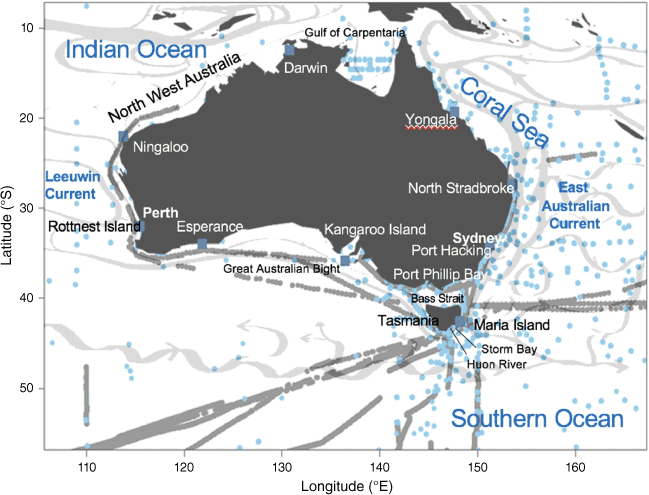
|
We here summarise and update dinophysoid species taxonomy in Australian tropical, subtropical, and temperate marine environments over the period 1938–2019, on the basis of 252 new National Reference Station and 129 Continuous Plankton Recorder samples, compare them with 9350 historical records curated in the Australian phytoplankton database, and then describe diversity, distribution and ecosystem implications.
Materials and methods
The full data base consulted for this study is summarised in Table 1 and sampling locations mentioned in the text are shown in Fig. 1. We also included recent sample collections in the Australian sector of the Indian Ocean made by R.V. Investigator along 110°E.

|
Three sampling approaches were used for both recent and historical data, as specified in Table 1.
Net sampling provided material for species taxonomy by light and electron microscopy. For oceanic surveys, we used a 37-µm free-fall plankton net with a weighted ring (Heron 1982) to propel it downward from surface to 100- to 200-m depth, but for selected inshore and offshore collections we used a small conical net (mouth diameter 23 cm, length 40 cm, cod-end diameter 4.5 cm) made of 20-µm monofilament nylon mesh, sampled from surface to 20-m depth. Zooplankton net sample collections using 100-µm mesh nets also proved to generate excellent dinophysoid material.
Water bottle sampling using 1-, 5-, 8- or 30-L Niskin bottles to sample from different depths. Water samples of 1-L volume or more were preserved (Lugol’s iodine solution, buffered formalin or glutaraldehyde) and concentrated by settling or centrifugation for quantitative cell counts by using an inverted or compound microscope.
The Continuous Plankton Recorder (CPR) collects plankton continuously from a standard depth of 6–10 m, towed behind ships of opportunity. The plankton cells are collected onto a constantly moving band of silk, which is wound into a tank of 4% formaldehyde. Although the silk mesh is 270 µm, it does retain many smaller cells down to 2 µm because of the nature of the twisted silk threads, the mesh constituting 30–40% of the mesh area, and through clogging. At the end of a voyage, the silks are cut into ~5-cm sections (representing ~5 nautical miles or ~9.26 km) and 20 fields analysed by light microscopy using a 63× objective and 10× ocular. The statistics of converting counts from silks to cell concentrations are described by Richardson et al. (2006).
Not all dinophysoid cells could be routinely identified to species level from all samples.
Light microscopy
Selected samples were examined under the microscope on board ship as soon as possible after collection while in the living state. Most samples were preserved either in Lugol’s iodine or using 2% formaldehyde fixative (buffered with hexamine). Cells were photographed with bright-field and differential interference contrast by using an Axioskop 2 Plus Zeiss microscope with Zeiss Axiocam HR digital camera. Samples processed as part of the NRS or CPR surveys were examined using phase contrast on a Leica DM2000 or DM6 microscope with Canon EOS 5D MkII camera. CPR silks were examined using a specially modified stage that enabled counting across the entire silk segment.
Scanning electron microscopy
Seawater samples (100 mL–3 L) were filtered gently onto Nuclepore filters (pore diameter 1 µm) immediately after collection. The filters were rinsed with 100 mL of distilled water to remove salt crystals and then air dried. Small pieces of filter were mounted on aluminium stubs, coated with gold, gold–palladium or platinum–palladium (5–20-nm layer thickness) and examined with a JEOL JSM-35C or JSM 840, Philips 515 or Hitachi SU70 scanning electron microscope (SEM) at 1.5–25 kV. Filtration immediately after collection minimised aggregation with detritus and structural deformation during air drying did not pose serious problems for dinophysoid cells.
Dinophysoid species composition
Full names with taxonomic authorities of all species discussed are listed in Table 2, and number of occurrence records and selected abundance estimates are compiled in Table 3.
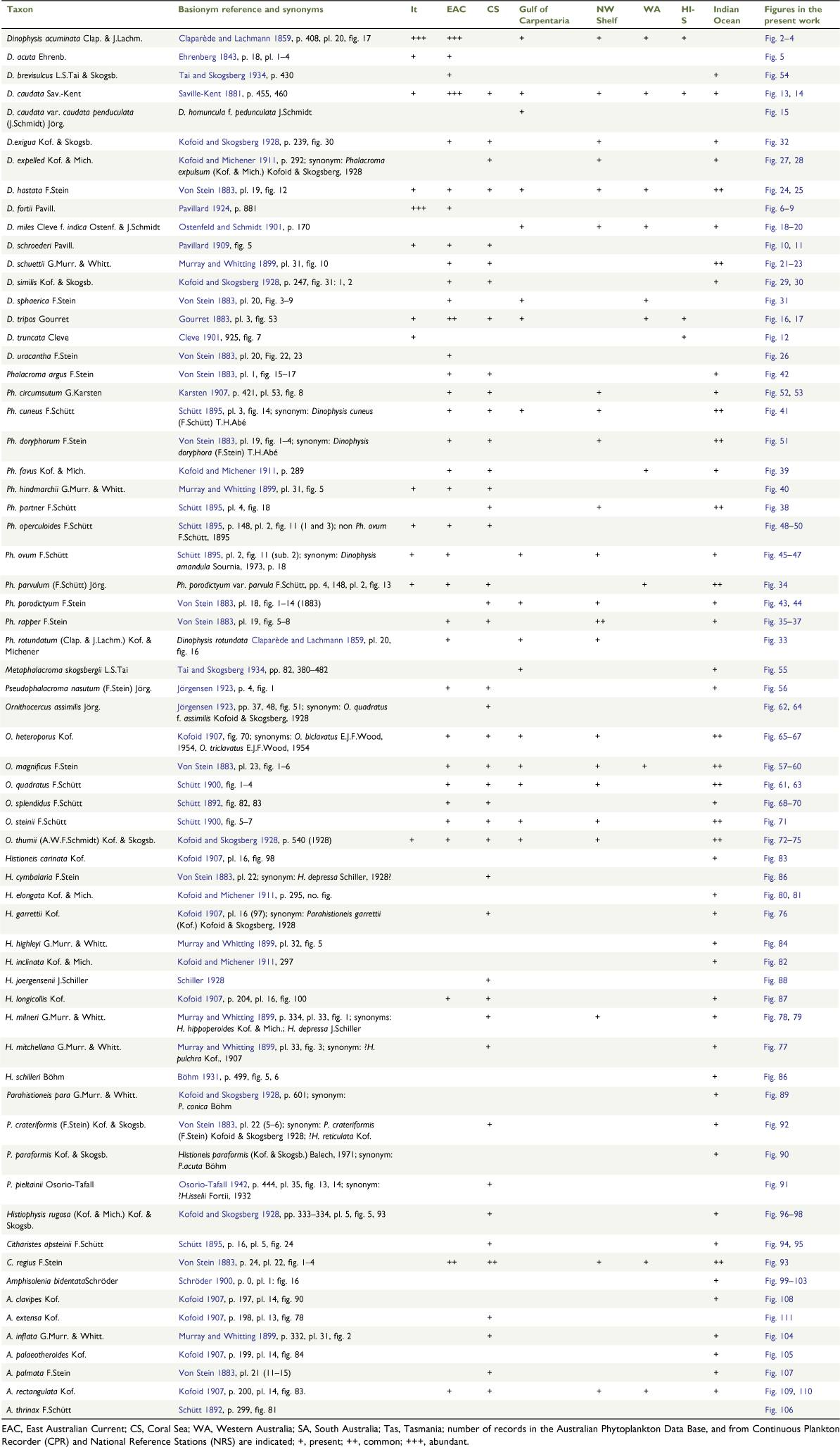
|
All data are available online at https://portal.aodn.org.au/search?uuid=75f4f1fc-bee3-4498-ab71-aa1ab29ab2c0.
Dinophysales undergo vegetative division by desmoschisis in which the mother cell material is distributed half-and-half between the two daughter cells, but there are some parts of the cell (e.g. sails) that cannot be symmetrically distributed (Taylor 1973). As a result, recently divided daughter cells can exhibit morphological differences of ribs, lists, spines, sails and thecal ornamentation compared with the mother cell. Concerning lists and ribs in the left sulcal lists, R1 goes to one daughter and R2 and R3 to the other daughter cell. Likewise, it is now well known from field population studies and from cultures, that dinoflagellates can undergo depauperating divisions to produce two small cells that were historically sometimes designated as a different species (Reguera and González-Gil 2001; Silva and Faust 2019).
Dinophysis and Phalacroma
Dinophysis cells are laterally flattened and divided into a small epitheca (top portion of cell) and a large hypotheca (bottom half; Fig. 2–32). The girdle is bordered by lists and the sulcus is also normally bordered by lists extending for a variable length along the hypotheca. Dinophysis and Phalacroma species overlap morphologically, but they can be separated by the development and direction of the cingular lists (Fig. 3), in combination with the height and shape of the epitheca. Dinophysis species have a much reduced epitheca and associated funnel-shaped anterior cingular lists (ACL) that curve upwards, but with Phalacroma, because of the larger epitheca, the girdle lists are horizontal (Fig. 33–53). The separation of Dinophysis and Phalacroma was first questioned by Tai and Skogsberg (1934), and, because of comparable plate tabulations, the two genera were synonymised by Abe (1967) and Balech (1967). However, on the basis of molecular phylogenetic data, Phalacroma was reintroduced and epitypified by Jensen and Daugbjerg (2009) and its diagnosis emended to ‘Epitheca large but <¼ of the cell length. It is visible above the cingular lists, and flattened to convex in outline. Cingular lists are narrow and horizontal and can possess ribs’ (p. 1147). Gómez (2021) formally proposed to conserve the name Phalacroma F.Stein over the little used name Prodinophysis Balech, which was created because of the earlier use of this name for the trilobite genus Phalacroma Hawle & Corda. Many of the species can also be separated by the presence (Dinophysis) or absence (Phalacroma) of chloroplasts (Hallegraeff and Lucas 1988), but there exist exceptions; for example, D. hastata F.Stein is colourless, whereas Ph. mitra F.Schütt contains kleptoplastids of haptophyte origin. The theca may be porate and have areoles or reticulations (Hallegraeff and Lucas 1988). For species identification, important features are size and shape of the cells, especially the outline of the main body and sulcal lists, whereas plate tabulation details are rarely used for taxonomy. The Australian Phytoplankton Database (Davies et al. 2016) as of May 2021 contained 8082 distribution records of taxa belonging to Dinophysis and 952 to Phalacroma.
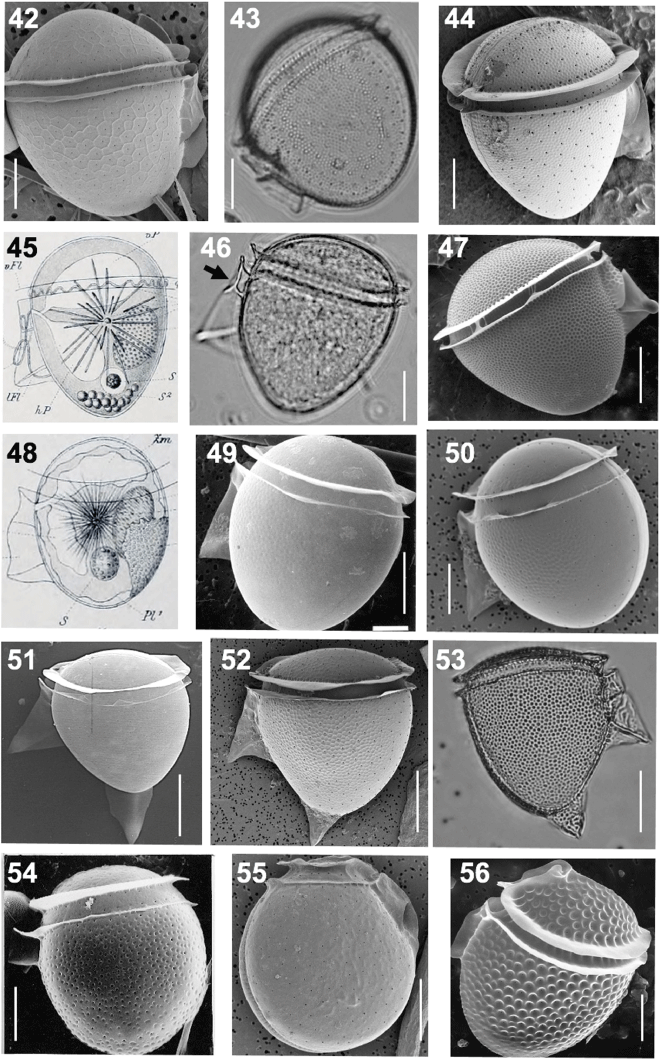
|
Prominent Dinophysis in Australian temperate waters are blooms of D. acuminata Clap. & J.Lachm. (4487 location records) and D. fortii Pavill. (447 records), with cell densities of up to 7380 cells L−1 having been recorded in Sullivans Cove, Tasmania, and up to 14 000 cells L−1 in the Huon River, Tasmania respectively (Wallace 2011; G. M. Hallegraeff, unpubl. data). D. acuminata is distinguished by its small size (38–58 µm long, 30–39 µm wide) and usually regular oval cell shape with some cells displaying minute protrusions on the bottom of the hypotheca (Fig. 2). This species is highly variable, commonly referred to as the D. acuminata species complex (Larsen and Moestrup 1992; Wolny et al. 2020), and the taxa D. boehmii Paulsen, D. borealis Paulsen, D. elliposoides Kof. and D. lachmanii Solum are all considered to be synonyms. We never conclusively identified the closely related D. sacculus Stein in Australian waters. D. skagii Paulsen has been interpreted as a life-cycle stage of D. acuminata (Reguera and González-Gil 2001). D. acuminata intergrades with D. ovum F.Schütt, which has the right sulcal list (RSL) ending close to the base of the second rib R2 of the left sulcal list (LSL; Raho et al. 2008), whereas in D. acuminata this list ends near the middle point between the bases of R2 and R3 (Fig. 3, 4, arrows). However, studies on Korean strains of D. acuminata and D. ovum could not categorically discriminate between the two species by morphological nor genetic criteria using the cox1 gene (Park et al. 2019). In this study, we did not conclusively identify D. ovum from Australian waters, and numerous cells that at first impression resembled D. ovum (Fig. 4) all exhibited the RSL features matching the definition of D. acuminata.
Dinophysis acuta Ehrenb. (134 records; Fig. 5) is in size similar to D. fortii (60–70 µm long, 35–40 µm wide; Fig. 6–9) and best identified by the prominent triangular posterior end of the hypotheca and with the cell body being widest below the middle of the hypotheca (Fig. 5, dotted line). The smaller, narrower D. dens Pavill. is considered to be a life-cycle stage of D. acuta (Reguera et al. 2004). D. fortii is typically distinguished by appearing broad, ‘bag-shaped’, with rounded antapices (dorsal bulge; Fig. 6, 8) and very straight ventral margin, but narrower forms can intergrade with D. acuta and D. acuminata. The LSL of D. fortii is much longer than that of D. acuminata and can extend to 4/5 of the hypotheca (Fig. 8, 9). D. acuta has been widely reported from New Zealand waters (MacKenzie et al. 2005) but rarely from Australian tropical, subtropical or temperate waters. Partial 28S rDNA gene sequences of Tasmanian D. fortii were indistinguishable from those of D. fortii from France and from D. acuta from New Zealand (Wallace 2011). Diarrhetic shellfish toxin profiles between Australia and New Zealand were also similar and it is possible that the New Zealand species designations have been confounded and refer to the same taxon D. fortii.
Dinophysis schroederi Pavill. (34 records) was encountered in this work only in the Coral Sea. The cells are ~1.8 times longer (70 µm length) than wide, and widest mid-distant between R2 and R3 (Fig. 10, 11). D. truncata Cleve (53 records) is a predominantly cold-water, Subantarctic species, which is rare in Tasmanian and South Australian waters, and also known from New Zealand (Burns and Mitchell 1982). Cells are 61–70 µm long and 37–49 µm wide, with a distinctive trapezoid hypotheca with flattened bottom, although this shape varies from smooth and straight to concave and bulbous or concave and wrinkled. The left sulcal list is typically widest at R3 and this rib is curved posteriorly (Fig. 12).
Common in Australian waters are the morphologically distinctive D. caudata Kent (1832 records) and D. tripos Gourret (589 records). Ajani et al. (2016) reported cell concentrations of 12 000 cells L−1 for D. caudata in the Hawkesbury River. Dinophysis caudata (Fig. 13, 14), 70–170 µm long, is irregularly subovate with long ventral hypothecal projections and is widest at the base of the sulcal list. It can be toothed on the posterior end. The most common D. caudata morphology in Australian temperate waters compares with var. abbreviata Jörgensen (Fig. 13, 14), whereas tropical, more slender forms have been discriminated as D. caudata var. pedunculata Schmidt (Fig. 15). Wood (1954, fig. 49a–g) noted that each area in Australia seems to have a characteristic form of D. caudata which is reasonably constant for that area. These forms deserve discrimination in future studies (compare Jörgensen 1923). We did not conclusively identify in Australian waters the D. diegensis Kofoid-like small cells (Rodríguez et al. 2012) of this species. Dinophysis tripos is anterior–posteriorly elongated, 94–105 µm long, with distinctive long antapical projections and short dorsal projections (Fig. 16). Morphologically identical cells are known from both Australian temperate (Fig. 16) and tropical waters, such as Ningaloo Reef, Western Australia, and the Gulf of Carpentaria (Fig. 17). Dinophysis miles Cleve f. indica Ostenf. & E.J.Schmidt (37 records) is a readily recognisable but rare tropical neritic species with maximum development of dorsal processes, up to 140–165 µm long (Fig. 18–20). The ventral margin of the hypotheca is straight or strongly wavy. Cell division can produce spectacular quadruplets or octuplets (Fig. 19, 20). This species has been exclusively observed by us in the port of Darwin, Gulf of Carpentaria, North-West Shelf and Rottnest Island, but Wood (1954) cites a single record from Port Hacking, NSW.
Dinophysis schuettii G.Murr. & Whitt. is a small species, 29–62 µm long, with round to subovate cell body and a curved, reinforced posterior sail that has a median rib joined to the marginal ribs (Fig. 21–23). The left sulcal list between R2 and R3 is concave and shorter than the ribs. The posterior spine is dorsal and curved to the right. This taxon has a predominantly warm-water oceanic distribution. Dinophysis hastata F.Stein is the commonest Dinophysis in Australian tropical waters (Fig. 24, 25). The medium-sized ovoid cells, 63–70 µm long, have a characteristic left sulcal list with the R3 rib typically curved distally. The cells carry a curved posterior spine, with list, which is directed ventrally. The nearest related species, D. uracantha F.Stein (Fig. 26), is distinguished on the basis of the dorso-antapical insertion of the antapical fin (arrowed) as opposed to ventro-antapical insertion in D. hastata (Fig. 24). The stylised original illustration of D. hastata by Von Stein (1883, pl. 19, fig. 12) shows a subovate cell with central antapical spine; however, later interpretations of this taxon (e.g. Taylor 1976, fig. 52, 54) included off-centre posterior spines. It is likely that more than one species is involved, and our cells in Fig. 24, 25 come closest to what has been called D. hastata var. uracanthides Jörgensen (see also Esqueda-Lara et al. 2013 for species discrimination within the D. hastata complex).
Dinophysis expulsa Kof. & Mich. (Fig. 27, 28) is a small distinctive species, 36 µm high, readily recognisable in ventral view with a wedge-shaped body with a marked depression (arrowed) ¼–1/3 the distance from the lower girdle list to the antapex. Dinophysis similis Kof. & Skogsb. has an asymmetrical ovate cell body with the posterior main rib of the left sulcal list well developed and the anterior girdle list with fine radial spokes (Fig. 29, 30, arrowed). The separation from D. sphaerica F.Stein (Fig. 31) is mainly based on the shape of the posterior portion of the LSL. Dinophysis exigua Kof. & Skogsb. is a small, 35–40 µm long, subglobular species, slightly compressed in lateral view (Fig. 32). The epitheca is very small and hypotheca is broadly rounded posteriorly. The LSL terminates ~0.6 of the cell length, continuously widening from R1 through R3. The RSL terminates at the base of R3. Both previous species exhibit girdle lists that are curving upwards and, hence, unambiguously belong to Dinophysis.
By contrast, Ph. rotundatum (Clap. & J. Lachm.) Kof. & Mich. (Fig. 33) belongs to a group of small to medium-sized species, 36–56 μm long, with a simple rotund lateral outline, without striking morphological features. Balech (1976a) redefined this taxon from Norwegian waters as having the LSL extending to >1/2 and almost 3/4 the length of the hypotheca (arrowed). Phalacroma parvulum (F.Schütt) Jörg. (Fig. 34) is 30–35 μm long, with subcircular lateral outline, deepest in the middle. The girdle lists are horizontal, approximately as wide as the girdle furrow.
The three strongly areolate species of Ph. mitra F.Schütt, Ph. rapa F.Stein, and Ph. favus Kof. & Mich. are common in tropical neritic waters. In our study, Ph. rapa (Fig. 35–37) was the most widespread. In Ph. rapa, the left ventral margin from R1 to R3 is angled, making the LSL extend out at approximately a 45–60° angle perpendicular to the depth axis. In the closely related Ph. mitra, the posterior portion of the hypotheca is concave from R3 to the antapex (Fig. 38), whereas Ph. favus is distinguished by its posterior finger-like projection (Fig. 39). Phalacroma hindmarchii G.Murr. & Whitt. shares the feature of a projecting antapex, but has a higher epitheca and the theca is more finely areolate (Fig. 40).
Phalacroma cuneus F.Schütt is a medium-sized species, 80–90 µm long, that is broadest anteriorly and narrowest posteriorly (Fig. 41). The left sulcal list is curved distally. The thecal surface is distinctive in being strongly reticulate with a pore in almost every depression. Phalacroma argus F.Stein has a higher epitheca, but similar but more delicate reticulate ornamentation (Fig. 42). The interpretation of Ph. porodictyum F.Stein by different authors has been inconsistent. The cells illustrated in Fig. 43, 44 are obovate or subellipsoidal in lateral outline, deepest at or somewhat behind the girdle. The RSL usually ends at or somewhat behind a point midway between the fission rib and the posterior main rib of the LSL. The thecal wall is faintly areolate with distinctive scattered larger pores.
The complex problem of Ph. ovum and Ph. operculoides
Large ovoid or almond-shaped Phalacroma cells with strongly raised epitheca have been variously referred to as Ph. ovum F.Schütt, Ph. operculoides F.Schütt, Ph. porodictyum F.Stein or D. amandula (Balech) Sournia, D. amandula Sournia or Ph. amandula (Balech) Sournia (e.g. Zinssmeister et al. 2017). The names Ph. operculoides (as the basionym of Dinophysis operculoides F.Schütt (Balech)) and Dinophysis amandula (Balech) Sournia are recognised in Algaebase (M. D. Guiry and G. M. Guiry, National University of Ireland, Galway Ireland, see https://www.algaebase.org), but Ph. ovum is listed as an invalid name, for which Schütt (1895, p. 90), stating ‘the taxonomic or nomenclatural status (or both) in some way is unresolved and requiring further investigation’ made an error by only mentioning the name Ph. ovum in the text when referring to pl. 2, fig. 11 (sub. 2; type illustration reproduced here as Fig. 45), but this figure was erroneously labelled as Ph. operculoides Schütt (1895, p. 148). The other illustrations of Ph. operculoides by Schütt’s pl. 2, fig. 11 (sub. 1 and 3) (reproduced here as Fig. 48) clearly are a different species. Although numerous later authors remarked that Schütt (1895) included two apparently different species, the taxonomic solutions proposed to solve this problem have varied.
Jörgensen (1923) accepted the name Ph. operculoides for Schütt’s pl. 2, fig. 11 (sub. 2) because the other figures were uncertain. Instead, Kofoid and Skogsberg (1928) interpreted Schütt’s pl. 2, fig. 11 (sub. 2) as Ph. ovum and pl. 2, fig. 11 (sub. 1 and 3) as Ph. operculoides. Balech (1967) accepted the taxon Ph. operculoides Schütt (which he transferred to Dinophysis), but when seeking to transfer Ph. ovum to Dinophysis recognised that this name was preoccupied by the distinct taxon D. ovum Schütt. Balech (1967) therefore created the new name D. amygdala for the larger ‘almond-shaped’ cell of Schütt’s (1895) pl. 2, fig. 11 (sub. 2). Sournia (1973) subsequently recognised that this name was preoccupied by D. amygdalus Paulsen (1949, p. 43, fig. 12B–D) and hence proposed the new name D. amandula Sournia. Under the International Code for Nomenclature, ICN Article 53.2 (Turland et al. 2018), when two names are so similar (amandula is Latin; amygdala is Greek, both meaning almond) that they are likely to be confused, they are to be treated as homonyms (see also Balech 1976b). Jensen and Daugbjerg (2009) produced convincing molecular evidence that Ph. cf. ovum belongs in Phalacroma. Options to solve this complex nomenclatural problem will be discussed in a separate communication.
In our work, the strongly poroid cells in Fig. 46, 47 from the East Australian Current and North West Australia compare to Schütt’s first species, referred here as Ph. ovum, but the smooth-walled cells with both minute and larger scattered pores in Fig. 49, 50 from the East Australian Current and Indian Ocean compare to Ph. operculoides F.Schütt. As pointed out by Balech (1988, pl. 10, fig. 16–17), the first species has a LSL that is narrower at the level of the R2 rib where it exhibits a reinforcement (Fig. 46, arrow), and the latter species has an oval cell shape, usually >50 µm long, the right sulcal fin almost extending to R3, with a straight border between R2 and R3.
The finely areolated cell in our Fig. 47 compares to what Taylor (1976) from the Indian Ocean referred to as D. porodictyum (pl. 4, fig. 45), but which is clearly distinct in ornamentation from our Ph. porodictyum illustrated in Fig. 43, 44. Delgado and Fortuño (1991) illustrated by SEM from the Mediterranean an identical areolated cell, which they identified as Dinophysis amandula Sournia (pl. 37, fig. a).
Other Phalacroma, Dinophysis and the related Metaphalacroma and Pseudophalacroma
Phalacroma doryphorum F.Stein has straight girdle lists and carries a characteristic triangular ribless posterior sail not connected to the LSL (Fig. 51). The ventral edge of the LSL is almost straight. Surface markings comprise shallow depressions with scattered pores. The similar Ph. circumsutum G.Karsten has the strong, single spine supporting the posterior list directed postero-ventrally, and exhibits more strongly ornamentation (Fig. 52, 53). Both species were rare in the Coral Sea, Great Australian Bight and Indian Ocean.
Fig. 54 with a very short sulcal list corresponds to Dinophysis brevisulcus L.S.Tai et Skogsb. as illustrated by Taylor (1976) from the Indian Ocean (pl. 4, fig. 34). This taxon is borderline between Dinophysis and Phalacroma, but the horizontal girdle lists (not curved upwards) suggest an affinity to the latter. We refrain from making a formal transfer until more material or, ideally, molecular sequences become available.
Metaphalacroma skogsbergii L.S.Tai (Fig. 55) belongs to a monospecific genus of uncertain taxonomic status and resembles the microcephalic, only known benthic dinophysoid genus Sinophysis Nie & Wang. This is a small subcircular dinophysoid with areolate theca, and the epitheca small and less wide than the hypotheca. The left and right girdle lists are very narrow and the posterior cingular list resembles a collar. Zinssmeister et al. (2017) provided a comparable SEM (fig. 3l) from the tropical eastern Pacific. Pseudophalacroma nasutum (F.Stein) Jörg., first described as Phalacroma nasutum Stein, was discriminated by Jörgensen (1923) from Phalacroma in having a prolongation of the ‘longitudinal furrow’ (sulcus) extending ~2/3 of the distance from girdle to apex. The cell shape is similar to that of Ph. rotundatum, but the ornamentation of the theca is much coarser with pit-like areolation, and no ribs are visible on the sulcal lists (Fig. 56). A single individual was observed by us in the Coral Sea and Wood (1954) reported one individual each from Port Hacking and Eden, NSW. Zinssmeister et al (2017) provided a comparable SEM of P. nasutum (fig. 3k) from the tropical eastern Pacific.
Other Dinophysis and Phalacroma species illustrated as poorly reproduced small line drawings by Wood (1954, 1963a, 1963b) include D. arctica Mereschk., D. okamurai Kof. & Skogsb., D. micropterygia P.Dangeard, D. parva J.Schiller, D. recurva Kof. & Skogsb., D. tuberculata Mangin, D. ventrecta J.Schiller, Ph. acutum (F.Schütt) Pavill., Ph. apicatum Kof. & Skogsb., Ph. contractum Kof. & Skogsb., Ph. dolichopterygium G.Murr. & Whitt., Ph. elongatum Jörg., Ph. irregulare M.Lebour, Ph. lens Kof. & Skogsb., Ph. lenticula Kof., Ph. minutum Cleve, Ph. mucronatum Kof. & Skogsb., Ph. operculatum F.Stein, Ph. porosum (Kof. & Mich.) Kof. & Skogsb., Ph. pulchellum M.Lebour, Ph. pulchrum (Kof. & Mich.) Jörg., Ph. rudgei G.Murr. & Whitt., Ph. striata Kof. and the newly created taxa D. hyalina E.J.F.Wood, D. carpentariae E.J.F.Wood, D. opposita E.J.F.Wood, D. pacifica E.J.F.Wood, D. moresbyensis E.J.F.Wood, Ph. alata E.J.F.Wood, Ph. jibbonense E.J.F.Wood, Ph. mawsonii E.J.F.Wood, Ph. thompsonii E.J.F.Wood, Ph. triangulare E.J.F.Wood and Ph. whiteleggei E.J.F.Wood. We did not confidently identify any of these taxa in our surveys.
Ornithocercus
In total, seven Ornithocercus species were encountered in Australian waters, and the Australian Phytoplankton Database contains 282 distribution records. They are small to medium-sized (trans-diameter 30–40 µm; height 70–80 µm) species, with a circular full body in lateral view, with extensive ornate sulcal and cingular list and rib systems that characterise the species. Ribs and lists are formed at the extremities of plates, near the sutures. Body-surface markings consist of pores or areolae. Ornithocercus all lack chloroplasts, but they often carry cyanobacterial ectosymbionts in their cingular chamber. Species of this genus can be differentiated by size and shape, notably of their list features even though these are subject to maturational changes (Taylor 1973). The most common species in Australian waters are O. magnificus F.Stein (40–45 µm long, with a trilobed posterior sail, typically 3 ribs extend towards the median lobe; Fig. 57–60), O. quadratus F.Schütt (45–62 µm long, with square posterior sail, lacking median posterior lobes; Fig. 61, 63), O. heteroporus Kof. (Fig. 65–67) and O. thumii (A.W.F.Schmidt) Kof. & Skogsb. 1928 (misspelled by Wood 1954 as O. thurni; with multilobed sails). Ornithocercus heteroporus is the smallest species, 26–33 µm long, 57–83 µm high, with a bilobed posterior LSL. Its name is deceptive because the pores and areolae are no different from O. quadratus or O. magnificus. Following Taylor (1973), we consider O. biclavatus E.J.F. Wood to be a junior synonym of O. heteroporus, from which it differs only in the presence of rugose reticular masses occupying the lobes of the LSL (Fig. 67). The variability of O. heteroporus, including forms with nearly square sulcal lists (Fig. 66) to the more typical bilobed sulcal lists in mature cells (Fig. 65, 67), is accounted for in its type description (Kofoid and Skogsberg 1928). The most ornate O. splendidus F.Schütt (50–60 µm long, with very extensive, posterior reticulate cingular lists; Fig. 68–70) and the type species O. steinii F.Schütt (Fig. 71) have rarely been observed in Australian waters. Ornithocercus steinii, 55–65 µm long, is often confused with O. thumii, but in O. steinii the b-rib terminates within the dorsal lobe, as opposed to that in O. thumii where the b-rib of the LSL terminates in a position distinctly ventral to the dorsal lobe of the list (Fig. 72–75). In O. quadratus and O. magnificus, one or two of the ribs are found on the inner side of the lists (usually the c-rib), whereas others are positioned on the outside; however, in O. steinii and O. thumii all ribs occur on one side of the LSL (Taylor 1973). We newly report from Australian waters O. assimilis Jörgensen 1923 emend. T.Wilke and Hoppenrath (Fig. 62, 64), previously treated as a forma of O. quadratus but distinguishable by its posteriorly bent fission rib and dense reticulation of mature anterior sulcal lists (Wilke et al. 2018). Although Wood’s (1954) distribution records of Ornithocercus were mainly confined to Australia’s eastern coast from Moreton Bay to Maria Island, Hallegraeff and Jeffrey (1984) added many new records from the Coral Sea, Gulf of Carpentaria and North West Shelf. The ongoing IMOS surveys have added new records from tropical Darwin, Ningaloo, Rottnest Island, and the Indian Ocean off North West Australia. Other Ornithocercus species reported from Australian waters by Wood (1954) include O. australis E.J.F.Wood (never reported since), O. carolinae Kof., O. carpentariae E.J.F.Wood (never reported since), O. formosus Kof. & Mich., and O. geniculatus P.Dangeard. We did not observe these taxa in our surveys.
Histioneis and Parahistioneis
Histioneis species are heterotrophic, small dinophysoids (20–30 µm wide, up to 90 µm long) with large subcircular, reniform or subreniform cell bodies with ornate list and rib systems and a large cingular chamber. They are a readily recognisable group, best collected in deep water-column net samples; however, species are poorly characterised owing to uncertainty of the degree of variability in cell size and girdle and list features accompanying maturity (Gómez 2007). The posterior cingular list is often cup-shaped, with the largest portion of cingulum being posterior and with vertical support ribs. The anterior cingular area is reduced, sometimes turned into a funnel with a small anterior cingular list. The membranous right sulcal list is reduced but the left sulcal list is extensive, sometimes including a window formed by the R2 rib bending posteriorly and anastomosing with the R3 rib. The cell body carries surface markings of pores or areolae.
In total, 11 Histioneis species were confirmed from Australian waters, and the Australian Phytoplankton Database contains 79 distribution records. Histioneis cells contain a large cingular chamber that hosts cyanobacterial ectosymbionts. The small, 30–32 µm long H. garretii Kof. (Fig. 76) represents a transition between Ornithocercus and Histioneis, with a large epitheca and long narrow left sulcal fin. In our material, H. mitchellana G.Murr. & Whitt. (130 µm long, with rounded tapering of reticulated sulcal list; Fig. 77), and H. milneri G.Murr. & Whitt. (reniform cell body with highly developed sulcal list with accessory lists; Fig. 78, 79) were the most common. Histioneis milneri is considered synonymous with H. helenae G.Murr. & Whitt. and H. hippoperoides Kof. & Mich. (Gómez 2007). Other taxa identified include H. elongata Kof. & Mich. (90–110 µm long, with a long striated R3 rib; Fig. 80, 81), H. inclinata Kof. & Skogsb. (27 µm long, with simple rounded body short left sulcal fin; Fig. 82), H. carinata Kof. (with narrow boat-shaped cell body; Fig. 83), H. highleyi G.Murr. & Whitt. (with Y-shaped areolated hypotheca; Fig. 84), H. cymbalaria F.Stein (25 µm long, with loop-shaped enforcement of the quandrangular window in its long left sulcal fin; Fig. 85), H. schilleri Böhm (small form with pointed tapering of sulcal list; Fig. 86), H. longicollis Kof. (round cell body with ventrally inclined sulcal list with circular window; Fig. 87) and H. joergensenii J.Schiller (with triangular window in left sulcal fin; Fig. 88).
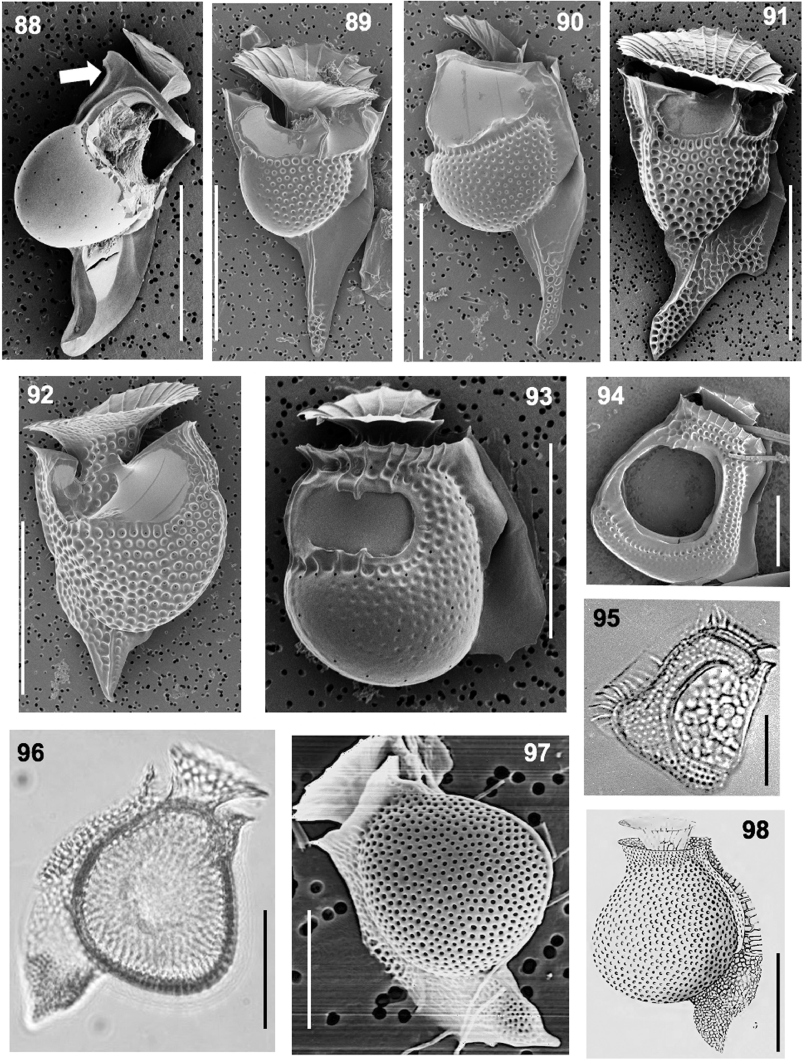
|
Considering the poorly defined genus Histioneis, unlike Balech (1988), but in agreement with Zinssmeister et al. (2017), we maintained the separate genus Parahistioneis Kof. & Skogsb., which is distinguished by the absence of the cross-rib in the lower cingular list (arrowed in Fig. 88) and tends to have solid-walled heavily areolated cells. This genus was represented by P. para G.Murr. & Whitt. (with hemispherical hypotheca and straight left sulcal fin, Fig. 89; synonymous with P. conica Böhm), P. paraformis Kof. et Skogsb. (42 µm long, with hemispherical hypotheca and dorsally curved sulcal fin; Fig. 90; synonymous with P. acuta Böhm), P. pieltainii Osorio-Tafall (Fig. 91; with very heavily areolated cell body and reticulated left sulcal fin) and the shorter, stubbier P. crateriformis (F.Stein) Kof. & Skogsb. sometimes considered to be synonymous with H. reticulata Kof. (Fig. 92). Our cell tentatively identified as P. pieltainii is smaller than P. diomedeae (Kof. & Mich.) Kof. & Skogsb. but distinct from P. karstenii (Kof. & Mich.) Kof. & Skogsb. in the direction of the terminal fin and more closely matches the deeply areolated cells illustrated by Osorio-Tafall (1942) from Mexico.
Other Histioneis species illustrated as line drawings from Australian waters by Wood (1954) include H. cerasus Böhm, H. costata Kof. & Mich., H. hyalina Kof. & Mich., H. inornata Kof. & Mich., H. megalocopa F.Stein, H. panaria Kof. & Skogsb., H. panda Kof. & Mich., H. pietschmannii Böhm, H. remora F.Stein, H. rotundata Kof. & Mich., H. tubifera Böhm, H. variabilis Schiller and H. vouckii J.Schiller. Several species newly characterised by Wood (1963b) have rarely or never been reported since, including H. aequatorialis E.J.F.Wood, H. australiae E.J.F.Wood, H. bougainvilleae E.J.F.Wood, H. diamantinae E.J.F.Wood, H. lanceolata E.J.F.Wood, H. moresbyensis E.J.F.Wood, H. planeta E.J.F.Wood, H. simplex E.J.F.Wood and P. gascoynensis E.J.F.Wood. We did not observe these taxa in our surveys.
Citharistes represents an unusual modification of the dinophysoid cell structure, with the small to medium-sized cell body deeply excavated on its dorsal side to create a C-shape in right lateral view. Enclosure of the cavity has been achieved by a shift in orientation of the lower girdle list and with the upper girdle list moved out of the ‘phaeosome’ chamber. The left sulcal list extends with ribs from the posterior cingular area to near the posterior part of the strongly areolate cell body. The smaller, 27–30 µm high, C. regius F.Stein (Fig. 93) was detected in the Indian Ocean and Coral Sea, and the larger, 59–65 µm high, C. apsteinii F.Schütt (Fig. 94, 95) was detected in the Coral Sea only. The latter species has a flat bottom, and rounded dorsal side of hypotheca. There exist only five distribution records of this genus in the Australian Phytoplankton Database and 49 global records in OBIS.
Histiophysis
Our rediscovery of the genus Histiophysis (Kof.& Mich.) Kof. & Skogsb., intermediate between Histioneis (with an extending sulcal list) and Dinophysis (with upwardly curved cingular lists), deserves special mention. Initially described as Dinophysis rugosa by Kofoid and Michener (1911), on the basis of a single individual collected in 1904 at a depth of 0–549 m in the Eastern Tropical Pacific during a voyage by the US Fish Commision Steamer Albatross, 15°5′S, 99°19′W, this taxon was later transferred to Histiophysis rugosa (Kof. & Mich., 1911) Kof. & Skogsb., 1928 (Kofoid and Skogsberg 1928, pp. 333–334, pl. 5, fig. 5, type illustration here reproduced as Fig. 98).
In our work, we collected two individuals from the Coral Sea, one on RV Sprightly cruise SP16/80, on 14 November 1980, 19.30°S, 152.40°E (Fig. 96), and a further one 6 years later on FRV Soela cruise SO1/86, on 26 January 1986, 23.00°S, 155.00°E (Fig. 97), in both cases using surface to 150-m deep 37-µm mesh net drops. This is a medium-sized species, with 45-µm body length, 35-µm body width, 62-µm total cell length, which is broadly ovate in lateral view, broadly rounded posteriorly and narrowly rounded anteriorly. It is deepest just behind the middle. The epitheca is ~0.26 times as deep as the hypotheca, and its shape is gently convex. Dorsally the transverse furrow is 0.20 times the greatest depth of the body and approximately twice as wide as ventrally. The posterior cingular list is ~0.1 times the length of the body from the apex. The hypotheca is subcircular, somewhat narrower anteriorly than posteriorly, and its margins are confluent. The anterior cingular list has a well developed funnel shape, which flares approximately twice as much dorsally as ventrally, with the dorsal side more concave than the ventral; with a flat, slightly inclined top and it has on each valve ~11–13 ribs. The posterior cingular list is narrower and more inclined than is the anterior, it lacks ribs but is heavily reticulated, a feature never seen in Dinophysis. The RSL is long, narrow, and heavily reticulated and extends to the fission rib of the LSL. The LSL ends somewhat ventrally to the antapex and increases gradually in width posteriorly. Its ventral margin is strongly curved and somewhat dorsal margin has a postero-ventral inclination of ~25°, is gently sigmoid, concave anteriorly and convex posteriorly, forms an acute angle of ~60° with the ventral margin, and its length is ~0.46 times the greatest depth of the body. The list has only one rib, the fission rib, located at a point approximately two-thirds the way from the apex to the antapex, deflected posteriorly at ~20°, and measuring 0.20 times the greatest depth of the body. In front of this rib the list is coarsely reticulated, most of the meshes being elongated transversely, and the margin is finely undulating. Behind this rib, the list is finely reticulated, and the margin is smooth. The thecal wall is finely, deeply and regularly areolated. Phaeosomes were described in the girdle of the type, but not seen in our formalin-preserved Coral Sea material.
Amphisolenia species are dinophysoid dinoflagellates, with the epitheca and cingulum forming a very small anterior ‘head’ on top a very thin and narrow body up to >1 mm in length (Fig. 99–101). Cells have often been interpreted as composed of a head, neck, shoulder, narrow body, sometimes with an inflated mid-region, and a foot. A portion of the plate surfaces are covered with pores (Fig. 103) The neck and shoulder have the sulcal plates and lists. The cingulum is circular (Fig. 100). The genus was represented by eight species in our material. Amphisolenia bidentata Schröder (with a foot end with two antapical spines; Fig. 103), is widespread. A. inflata Murr. & Whitt. (with inflated central cell body; Fig. 104), A. palaeotheroides Kof. (with a differentiated foot with heel spine and 3 antapical spines; Fig. 105), the spectacular Neptune’s fork shaped A. thrinax F.Schütt (with 2 lateral antapical branches arising from the main antapical stem; Fig. 106), A. palmata F.Stein (with 3 antapical spines; Fig. 107), A. clavipes Kof. (with curled foot end; Fig. 108), A. rectangulata Kofoid (with 4 antapical spines; Fig. 109, 110 and A. extensa Kof. (club-shaped areolate foot without spines; Fig. 111) were mostly observed as single specimens in the Coral Sea or Indian Ocean only. In total, 211 distribution records of this genus exist in the Australian Phytoplankton Database. Other Amphisolenia species illustrated as line drawings by Wood include A. astralagus Kof. & Mich., A. bifurcata Murr. & Whitt., A. bispinosa Kof., A. brevicauda Kof., A. curvata Kof., A. globifera F.Stein, A. laticincta Kof., A. lemmermanii Kof., A. schauinslandi Lemmerm., A. schroederi Kof. and the related Triposolenia bicornis Kof. (Wood 1963b). We did not observe these taxa in our surveys.
On the identity of Ornithocercus, Histioneis, Citharistes, Amphisolenia, Phalacroma and Dinophysis ecto- and endosymbionts
The tropical dinophysoid genera Ornithocercus, Histioneis and Citharistes commonly host coccoid symbionts (referred to as ‘phaeosomes’ in older literature; Schütt 1895), either externally associated with their girdle lists (Fig. 58, 61), or internally contained within special chambers (Fig. 84, 95). Lucas (1991) was the first to characterise these pigmented phaeosomes from Australian dinophysoids by transmission electron microscopy, which allowed him to discriminate three or four prokaryote morphotypes, often present in mixtures within the same dinoflagellate host. Some 22 years later, Foster et al. (2006) used molecular polymerase chain reaction (PCR) techniques to confirm their identity as three clades of Prochlorococcus and one strain of Synechococcus. Kim et al. (2021), using 16S rDNA, confirmed three genetic types of Synechococcales in Ornithocercus, similarly often present in mixtures, some being host-specific but others common to the genus or shared with Histioneis, Amphisolenia and Citharistes. Lucas (1991) also identified one or two types of eukaryote endosymbionts inside Amphisolenia (Fig. 102, 104). Some 25 years later, by using molecular techniques, their identity was confirmed by Daugbjerg et al. (2013) as pelagophytes. The kleptochloroplasts of several Dinophysis and Phalacroma species were characterised by transmission electron microscopy by Hallegraeff and Lucas (1988), and subsequently identified by genetic methods as having either cryptomonad affinities (D. fortii, D. acuminata; Hackett et al. 2003; see also Schnepf and Elbrächter 1988), or a mixture of cryptophytes, haptophytes and cyanobacteria (in D. miles; Qiu et al. 2011). Chloroplasts were absent in D. hastata, D. schuettii, Ph. favus, Ph. parvulum, Ph. cuneus, but an unidentified eukaryote symbiont was observed within Ph. rapa (Hallegraeff and Lucas 1988). Koike et al. (2005), by using genetic methods, later identified kleptoplastids of haptophyte origin symbiont in the related Ph. mitra (see also Tarangkoon et al. 2010).
Diarrhetic shellfish toxin (DST) producers
At least 10 Dinophysis and two Phalacroma species, namely Ph. mitra and Ph. rotundatum, have been demonstrated to contain diarrhetic shellfish toxins, DST (Reguera et al. 2012), whereas others potentially could be toxigenic but are commonly present in too low cell concentrations to cause problems. Evidence for toxigenicity of the only heterotrophic species, Ph. rotundatum, is doubtful (González-Gil et al. 2011). This taxon may be not a toxin-producer de novo, but a vector of DST toxins taken from its tintinnid prey they had previously fed on. In Australian waters, the key species of concern able to achieve high cell abundances are D. acuminata, D. caudata, D. fortii, and D. tripos. D. tripos has never been conclusively associated, yet, with any toxic event in Australian waters. A significant human poisoning event occurred in 1997 in Ballina, NSW, resulting in 102 people being affected, with 56 hospitalisations, resulting from bivalve consumption of pipis (Plebidonax deltoides) contaminated with PTX-seco acids and dinophysistoxin-3 (DTX-3) from D. acuminata and D. caudata (Quaine et al. 1997; Burgess and Shaw 2001). In March 1998, a second outbreak was reported, in which 20 cases of DSP were reported (Hallegraeff et al. 2021). Since then, DSTs have been a major food-safety challenge for the NSW pipi industry, with up to 40% of pipis in an end-product market survey between 2015 and 2017 returning positive results for DST, and two market-place samples above the regulatory limit (Farrell et al. 2018). DST in pipis and Dinophysis concentrations continue to be monitored in the Ballina area (Farrell et al. 2020). DSTs have also been occasionally detected in shellfish from Tasmania. During 2003–2004, high seasonal abundance of D. acuminata and associated D. fortii (up to 7380 cells L−1 for D. acuminata, 500 cells L−1 for D. fortii) in Sullivan’s Cove, Hobart, was associated with the detection of okadaic acid (OA) + dinophysistoxin-1 (DTX-1) in the digestive gland of non-commercial mussels (Mytilus edulis) with pectenotoxin-2 (PTX-2), PTX-2 seco acids and 7-epi-PTX-2 SA also being present (Wallace 2011). In Tasmania, DST was responsible for a recall of mussels from Spring Bay in 2016 (0.56 mg kg−1 okadaic acid equivalent). Although a low risk, positive DST detections also occurred in shellfish from South Australia in 2000–2001 (Madigan et al. 2006) and Western Australia (but never exceeding regulatory levels of 0.20 mg kg−1 OA equivalents).
Phylogenetic relationships
Several molecular phylogenetic investigations have attempted to evaluate dinophysoid character evolution as hypothesised on the basis of morphology, but with limited results. On current evidence, planktonic dinophysoids are not monophyletic (Go’mez et al. 2012). Genetic studies of Dinophysis species have largely focused on the toxigenic species D. acuminata, D. acuta, D. caudata, D. norvegica Clap. & J.Lachm. and D. tripos. Striking morphological differences between, for example, D. norvegica and D. acuminata (Edvardsen et al. 2003) and within the D. acuminata–D. sacculus F.Stein complex (Séchet et al. 2021), or attempts to separate D. acuminata and D. ovum (Park et al. 2019; Raho et al. 2008), have all encountered very limited genetic support. Generally, species of Dinophysales are best discriminated using a combination of sequences of the mitochondrial cox1 gene and the ITS1–SSU rDNA ITS2 gene, and with poor results by using LSU rDNA (Edvardsen et al. 2003; Gómez et al. 2011; Handy et al. 2009). Identical LSU rDNA sequences were thus observed for the morphologically distinctive D. tripos, D. miles and D. odiosa (Pavill.) L.S.Tai & Skogsb. (Jensen and Daugbjerg 2009). Similarly, Jensen and Daugbjerg (2009) found identical LSU rDNA gene sequences for O. quadratus and O. steinii, and SSU sequences of two O. quadratus varieties (var. quadratus (Jörg.) Taylor and f. schuettii Kofoid & Skogsb.) were identical in the study by Gómez et al. (2011). However, uniform genetic support has now been achieved for the separation of Phalacroma from Dinophysis (Jensen and Daugbjerg 2009), which we adopted here throughout.
Lack of success in culturing most dinophysoid species has limited our understanding of morphological variability by individual taxa and has contributed to the paucity of molecular sequences available. The first cultures of mixotrophic Dinophysis were achieved only in 2006 by feeding with the phototrophic ciliate Mesodinium rubrum, which in turn had been fed with cryptomonads such as Teleaulax, Plagioselmis and Geminigera (Park et al. 2006). As far as known to us, heterotrophic dinophysoids have not yet been cultured, with the exception of feeding experiments with freshly caught dinoflagellates in laboratory experiments, such as, for example, Ph. rotundatum feeding on the ciliate Tiarina fusus (Hansen 1991). The extreme rarity of tropical genera such as Histioneis and Amphisolenia undoubtedly has contributed to the fact that many species have never been reported since their initial description (Wood 1954, 1963a, Gómez 2007; 1963b). This is reflected in the extraordinary number of 91 Histioneis species formally described, of which 35 taxa have been observed only once, so-called ‘orphan’ taxa (Gómez 2007). Histioneis, Parahistioneis and Ornithocercus species remain especially poorly characterised owing to uncertainty of degree of variability in cell size and girdle and list features accompanying maturity (Taylor 1973). Similarly, non-descriptive small Ph. rotundatum-like taxa have rarely been correctly identified to species level (Daugbjerg et al. 2019).
Species distributions
The island continent of Australia is surrounded by surface and subsurface boundary currents that flow along the continental shelf and slope. The unique feature of this circulation is that along both eastern and western coasts, boundary currents transport warm-water southward via the East Australian and Leeuwin currents respectively (Fig. 1, Wijeratne et al. 2018). These boundary currents are enhanced through inflows from the South Pacific and South Indian Ocean basins, and represent an important conduit for the poleward heat and mass transport and inter-ocean water exchange in the tropics. Table 3 compiles the number of occurrence records for the most common taxa, ranging from 4467 for D. acuminata, 1754 for D. caudata, but being down to 246 for all combined Ornithocercus and 75 for all combined Histioneis species. Typical background abundance levels from routine offshore Continuous Plankton Recorder tows ranged from 0.67 to 3.33 cells L−1, and typically 5–10 Ornithocercus or Histioneis cells were observed of 100–1000 net-phytoplankton cells (0.0001–1% of total phytoplankton volume; Hallegraeff and Jeffrey 1984); however, selected surveys in estuaries have yielded Dinophysis concentrations of 3000–14 000 cells L−1. Table 2 tabulates regional distribution patterns of all taxa discussed.
Some dinophysoids such as D. acuminata, D. caudata, D. fortii and D. tripos occur both in tropical and temperate Australian waters (Fig. 112), but many others have strong warm-water preferences. Temporal shifts in sampling efforts in the periods 1940–1960, 1960–1980, 1980–2000, and 2000–2019 reflect the focus of different analysts (Wood 1954, 1963a, 1963b; Hallegraeff and Jeffrey 1984; Hallegraeff and Reid 1986; Jeffrey and Hallegraeff 1987; Eriksen et al. 2019; IMOS, since 2009; and others). Furthermore, water-column net samples consistently retrieved a higher diversity of dinophysoid species than did Continuous Plankton Recorder silks (CPR; towed offshore and subsurface only) and water-bottle samples (as in the National Reference Stations, NRS). In our work, D. hastata was one of the common Dinophysis species in Australian tropical waters (63 observations; Fig. 113a), whereas D. miles was exclusively observed in the Gulf of Carpentaria, North-West Shelf, Darwin, and off Rottnest Island (39 observations; Fig. 113e). Dinophysis schuettii (n = 51; Fig. 113b) had a predominantly warm-water oceanic distribution in the Coral Sea and East Australian Current, but has been rarely observed in shallow shelf waters of tropical north-western Australia. Dinophysis truncata (n = 53) is a Subantarctic species, rare in Tasmanian and South Australian waters but also known from New Zealand (Burns and Mitchell 1982). The three strongly areolate species of Ph. mitra (n = 75; Fig. 113g), Ph. rapa (n = 37; Fig. 113h) and Ph. favus (19) were common in tropical neritic waters. In our study, Ph. mitra was the most widespread. Ornithocercus and Histioneis are stenotherm warm-water species. O. quadratus (n = 84; Fig. 113f) was more common inshore, and O. magnificus (n = 56; Fig. 113d) and notably O. heteroporus (n = 26; Fig. 113c) were more common offshore. The rare genus Citharistes has never been reported south of Brisbane (Fig. 113a). Unlike Dinophysis, Phalacroma and Ornithocercus, the genera Amphisolenia and Histioneis (Fig. 113b) were never observed in estuaries. Although Wood’s (1954) distribution records of Ornithocercus were mainly confined to Australia’s eastern coast, from Moreton Bay to Maria Island, Hallegraeff and Jeffrey (1984) added many new records from the Coral Sea, Gulf of Carpentaria and North West Shelf, and the present IMOS work added numerous new records from coastal stations off Darwin, Ningaloo and Rottnest Island. Ornithocercus species only very rarely have been detected as far south as Tasmania off Maria Island (September 1984) and in the Huon River (July 2016, with cyanobacterial symbionts present). These warm-water species can occasionally be carried southward by the East Australian Current and Leeuwin Current (Fig. 1); however, they are not persistent residents in these waters (Fig. 114).

|
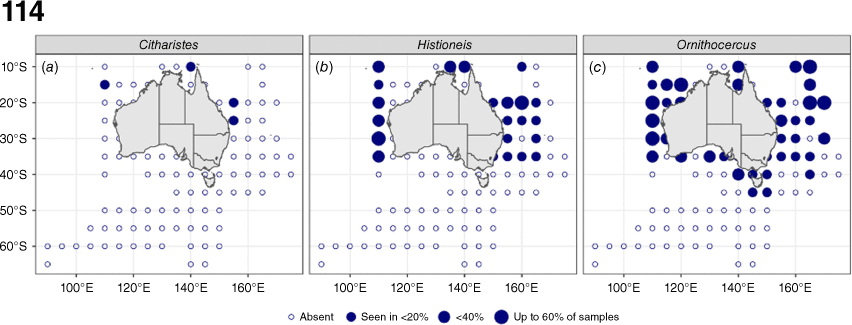
|
In total, the present work analysed 9350 Australian records of 64 confirmed species of marine planktonic dinophysoid dinoflagellate genera, including the genera Dinophysis (17 species; 8082 records), Phalacroma (12; 953 records), Metaphalacroma (1), Pseudophalacroma (1), Ornithocercus (7 spp.; 289 records), Histioneis (11 spp.; 102 records), Parahistioneis (4), Histiophysis (1; 2 records), Citharistes (2; 5 records) and Amphisolenia (8; 223 records). Wood’s (1954) early survey of Australian waters reported a comparable 50 species, but his later observations (Wood 1963a, 1963b) from the Coral Sea and Indian Ocean yielded a further 67, although poorly defined, species, many of which have never been reported since and remain of uncertain status.
Comparable surveys on the tropical Mexican Pacific by Esqueda-Lara and Hernández-Becerril (2010) and Hernández-Becerril et al. (2021) yielded 34–56 species, Omura et al. (2012) reported 73 species from the western Pacific, Balech (1988) reported 82 species from the South West Atlantic, and Zinssmeister et al. (2017) found 75 species from the eastern Pacific. Dinophysoid dinoflagellates in the Indian Ocean were characterised by Taylor (1976) who reported 48 spp. (summarised in Table 4). None of these surveys matched the astounding work by early pioneers such as Kofoid and Michener 1911; Kofoid and Skogsberg 1928; Tai and Skogsberg 1934) in the eastern Pacific documenting 132 species of which 88 were new to science. We newly report from Australian waters O. assimilis Jörg., Metaphalacroma skogsbergii L.S.Tai, Parahistioneis pieltainii Osorio-Taffal, Amphisolenia extensa Kof., A. inflata G.Murr. & Whitt. and A. rectangulata Kof. We should never underestimate the extraordinary observation skills by these early workers as demonstrated here by the rediscovery of Histiophysis rugosa (Kof.& Mich.) Kof. & Skogsb. collected in 1904 from the tropical eastern Pacific on the basis of a single individual only, but here observed with two further cells collected from the Coral Sea in 1980 and 1986 respectively. That is, only three cells were observed in the entire world oceans in 100+ years. These rarer tropical species deserve careful attention in monitoring for future range expansions, changes in seasonality or upwelling or incursion of deep tropical waters, but call for water-column net samples for appropriate collection.
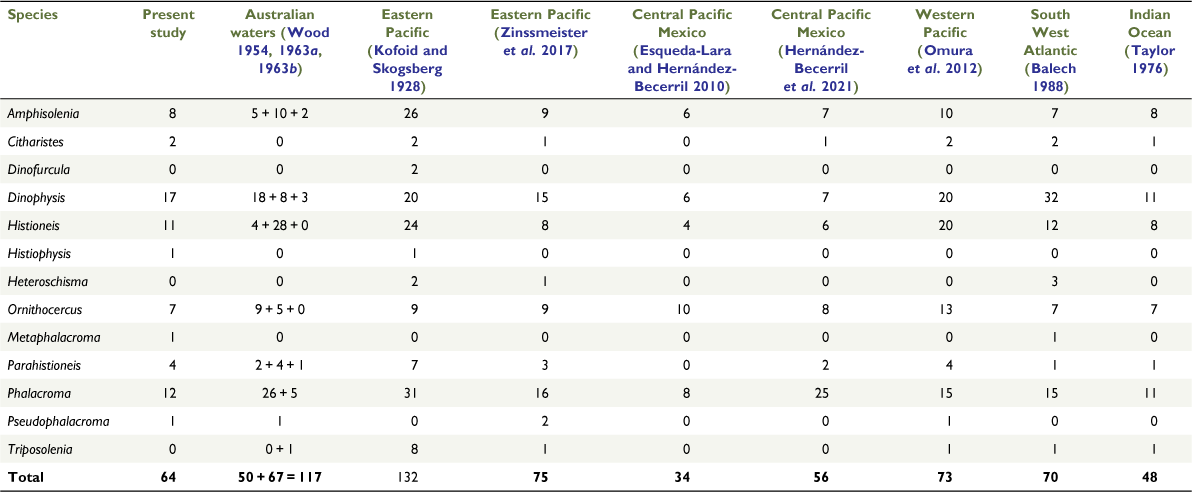
|
Data availability
All data are available online from the Australian Phytoplankton Database (https://portal.aodn.org.au/search?uuid=75f4f1fc-bee3-4498-ab71-aa1ab29ab2c0), the Australian Continuous Plankton Recorder Survey (https://portal.aodn.org.au/search?uuid=c1344979-f701-0916-e044-00144f7bc0f4) and the National Reference Station (https://portal.aodn.org.au/search?uuid=dfef238f-db69-3868-e043-08114f8c8a94).
Conflicts of interest
The authors declare that they have no conflicts of interest.
Declaration of funding
IMOS is enabled by the National Collaborative Research Infrastructure Strategy (NCRIS). It is operated by a consortium of institutions as an unincorporated joint venture, with the University of Tasmania as Lead Agent.
Acknowledgements
We thank Prof. Anthony Richardson for his leadership of the AusCPR program, and Frank Coman, Mark Tonks, Anita Slotwinski and Felicity McEnnulty for help with the ongoing phytoplankton surveys and management of imaging records. Helen Bond from Analytical Services Tasmania kindly shared her Tasmanian Ornithocercus observations. We thank Consuelo Carbonell-Moore (Oregon State University, USA) for drawing our attention to the significance of Histiophysis. Prof. Martina Doblin kindly gave us access to Investigator IN2019-V03 Indian Ocean samples. We thank Assoc. Prof. Maret Vesk from the Electron Microscope Unit of Sydney University and Dr Karsten Goemann and Dr Sandrin Feig from the Central Science Laboratories of the University of Tasmania for expert assistance with electron microscopy. Comments from three anonymous reviewers greatly improved the paper.
References
Abe TH (1967) The armoured dinoflagellata: II. Prorocentridae and Dinophysidae (B). Dinophysis and its allied genera. Publications of the Seto Marine Biological Laboratory 15, 37–78.| The armoured dinoflagellata: II. Prorocentridae and Dinophysidae (B). Dinophysis and its allied genera.Crossref | GoogleScholarGoogle Scholar |
Ajani P, Larsson ME, Rubio A, Bush S, Brett S, Farrell H (2016) Modelling bloom formation of the toxic dinoflagellates Dinophysis acuminata and Dinophysis caudata in a highly modified estuary, south eastern Australia. Estuarine, Coastal and Shelf Science 183, 95–106.
| Modelling bloom formation of the toxic dinoflagellates Dinophysis acuminata and Dinophysis caudata in a highly modified estuary, south eastern Australia.Crossref | GoogleScholarGoogle Scholar |
Balech E (1967) New or interesting dinoflagellates from the Gulf of Mexico and the Caribbean. Revista Museo Argentina de Ciencias Naturales Bernardino Rivadavia. Hidrobiologia 2, 87–135. [In Spanish]
Balech E (1976a) Some Norwegian Dinophysis species (Dinoflagellata). Sarsia 61, 75–94.
Balech E (1976b) Notas sobre el genero Dinophysis (Dinoflagellata). Physis A 35, 183–193. [In Spanish]
Balech E (1988) Los dinoflagelados del Atlantico sudoccidental. Publications Especial Instituto Espanol Oceanograficos 1, 310 [In Spanish]
Böhm A (1931) Peridineen aus dem Persischen Golf und dem Golf von Oman. Achive für Protistenkunde 74, 188–197. [In German]
Burgess V, Shaw G (2001) Pectenotoxins – an issue for public health: a review of their comparative toxicology and metabolism. Environment International 27, 275–283.
| Pectenotoxins – an issue for public health: a review of their comparative toxicology and metabolism.Crossref | GoogleScholarGoogle Scholar |
Burns DA, Mitchell JS (1982) Dinoflagellates of the genus Dinophysis Ehrenberg from New Zealand coastal waters. New Zealand Journal of Marine and Freshwater Research 16, 289–298.
| Dinoflagellates of the genus Dinophysis Ehrenberg from New Zealand coastal waters.Crossref | GoogleScholarGoogle Scholar |
Cleve PT (1901) Plankton from the Indian Ocean and the Malay Archipelago. Kungliga Svenska Vetenskapsakademiens Handlingar 35, 8–58. [In Swedish]
Claparède E, Lachmann J (1859) Studies on infusories and rhizopods Mémoires de l’Institut National Genevois 6, 261–482. [In French]
Daugbjerg N, Jensen MH, Hansen PJ (2013) Using nuclear-encoded LSU and SSU rDNA sequences to identify the eukaryotic endosymbiont in Amphisolenia bidentata. Protist 164, 411–422.
| Using nuclear-encoded LSU and SSU rDNA sequences to identify the eukaryotic endosymbiont in Amphisolenia bidentata.Crossref | GoogleScholarGoogle Scholar |
Daugbjerg N, Hansen SA, Richardson K (2019) Cryptic diversity of small-sized species of Phalacroma (Dinophysales, Dinophyceae) from Denmark Strait (eastern Arctic Greenland). Phycological Research 67, 244–249.
| Cryptic diversity of small-sized species of Phalacroma (Dinophysales, Dinophyceae) from Denmark Strait (eastern Arctic Greenland).Crossref | GoogleScholarGoogle Scholar |
Davies CH, Hallegraeff G, Ajani P, Armbrecht L, Bonham P, Brett S, Burford M, Clementson L, Coman F, Coughlan A, Davies D, Dela-Cruz J, Devlin M, Edgar S, Eriksen R, Furnas M, Hassler C, Ingleton T, Leterme SC, McEnnulty F, Miller M, Nayar S, Pritchard T, Proctor R, Purcell D, Slotwinski A, Tattersall K, Thompson P, Tonks M, Trull T, Uribe-Palomino J, Swadling K, Zammit A, Richardson AJ (2016) A database of marine phytoplankton abundance, biomass and species composition in Australian waters. Scientific Data 3, 160043
| A database of marine phytoplankton abundance, biomass and species composition in Australian waters.Crossref | GoogleScholarGoogle Scholar |
Delgado M, Fortuño J-M (1991) Atlas of Phytoplankton of the Mediterranean Sea. Scientia Marina 55, 1–133. [In Spanish]
Edvardsen B, Shalchian-Tabrizi K, Jakobsen KS, Medlin LK, Dahl E, Brubak S, Paasche E (2003) Genetic variability and molecular phylogeny of Dinophysis species (Dinophyceae) from Norwegian waters inferred from single cell analyses of rDNA. Journal of Phycology 39, 395–408.
| Genetic variability and molecular phylogeny of Dinophysis species (Dinophyceae) from Norwegian waters inferred from single cell analyses of rDNA.Crossref | GoogleScholarGoogle Scholar |
Ehrenberg CG (1839) Über jetztwirklich noch zahlreich lebende Thier‐Arten der Kreideformation der Erde. Berichtüber die zur Bekanntmachung geeigneten Verhandlungen der Königl. Preuß.Akademie der Wissenschaften zu Berlin 152–159. [In German]
Eriksen RS, Davies CH, Bonham P, Coman FE, Edgar S, McEnnulty FR, McLeod D, Miller MJ, Rochester W, Slotwinski A, Tonks ML, Uribe-Palomino J, Richardson AJ (2019) Australia’s long-term plankton observations: the Integrated Marine Observing System National Reference Station network. Frontiers in Marine Science 6, 161
| Australia’s long-term plankton observations: the Integrated Marine Observing System National Reference Station network.Crossref | GoogleScholarGoogle Scholar |
Esqueda-Lara K, Hernández-Becerril DU (2010) ‘Marine microplanktonic dinoflagellates of the central Pacific of Mexico (Isabel Island, Nayarit and coasts of Jalisco and Colima). Institute of Marine Sciences and Limnology.’ (National Autonomous University of Mexico: Mexico City, Mexico)
Esqueda-Lara K, Parra-Toriz D, Hernández-Becerril DU (2013) Morphology and taxonomy of Dinophysis species of the section Hastata (Dinoflagellata), including the description of Dinophysis conjuncta sp. nov., from the Mexican marine waters. Journal of the Marine Biological Association of the United Kingdom 93, 1187–1202.
| Morphology and taxonomy of Dinophysis species of the section Hastata (Dinoflagellata), including the description of Dinophysis conjuncta sp. nov., from the Mexican marine waters.Crossref | GoogleScholarGoogle Scholar |
Farrell H, Ajani P, Murray S, Baker P, Webster G, Brett S, Zammit A (2018) Diarrhetic shellfish toxin monitoring in commercial wild harvest bivalve shellfish in New South Wales, Australia. Toxins 10, 446
| Diarrhetic shellfish toxin monitoring in commercial wild harvest bivalve shellfish in New South Wales, Australia.Crossref | GoogleScholarGoogle Scholar |
Farrell H, Ajani P, Murray S, Baker P, Webster G, Brett S, Barua A, Zammit A, Hill D (2020) Time series of harmful algal blooms in New South Wales. Case Study 1. Dinophysis time series at South Ballina Beach. Integrated Marine Observing System, State and Trends of Australia’s Oceans Report, IMOS, Hobart, Tas., Australia.
Foster RA, Collier JL, Carpenter EJ (2006) Reverse transcription PCR amplification of cyanobacterial symbiont16SrRNA sequences from single non-photosynthetic eukaryotic marine planktonic host cells. Journal of Phycology 42, 243–250.
| Reverse transcription PCR amplification of cyanobacterial symbiont16SrRNA sequences from single non-photosynthetic eukaryotic marine planktonic host cells.Crossref | GoogleScholarGoogle Scholar |
Gómez F (2007) Synonymy and biogeography of the dinoflagellate genus Histioneis (Dinophysiales: Dinophyceae). Revista De Biologia Tropical. 55, 459–477.
| Synonymy and biogeography of the dinoflagellate genus Histioneis (Dinophysiales: Dinophyceae).Crossref | GoogleScholarGoogle Scholar |
Gómez F (2021) (2833) Proposal to conserve the name Phalacroma (Dinophysales: Dinophyceae). Taxon 70, 1127–1128.
| (2833) Proposal to conserve the name Phalacroma (Dinophysales: Dinophyceae).Crossref | GoogleScholarGoogle Scholar |
Gómez F, López-García P, Moreira D (2011) Molecular phylogeny of dinophysoid dinoflagellates: the systematic position of Oxyphysis oxytoxoides and the Dinophysis hastata group (Dinophysales, Dinophyceae). Journal of Phycology 47, 393–406.
| Molecular phylogeny of dinophysoid dinoflagellates: the systematic position of Oxyphysis oxytoxoides and the Dinophysis hastata group (Dinophysales, Dinophyceae).Crossref | GoogleScholarGoogle Scholar |
Gómez F, Moreira D, López-García P (2012) Sinophysis and Pseudophalacroma are distantly related to typical dinophysoid dinoflagellates (Dinophysales, Dinophyceae). Journal of Eukaryotic Microbiology 59, 188–190.
| Sinophysis and Pseudophalacroma are distantly related to typical dinophysoid dinoflagellates (Dinophysales, Dinophyceae).Crossref | GoogleScholarGoogle Scholar |
González-Gil S, Pizarro G, Paz B, Velo-Suárez L, Reguera B (2011) Considerations on the toxigenic nature and prey sources of Phalacroma rotundatum. Aquatic Microbial Ecology 64, 197–203.
| Considerations on the toxigenic nature and prey sources of Phalacroma rotundatum.Crossref | GoogleScholarGoogle Scholar |
Gourret P (1883) Sur les Péridiniens du Golf de Marseille. Annales du Musée d’Histoire Naturelle de Marseille, Section du Zoologie 1 (Mémoire 8) 5–114. [In French]
Gul S, Saifullah SM (2007) Genus Amphisolenia Stein from north-west Arabian sea shelf of Pakistan. Pakistan Journal of Botany 39, 561–576.
Gul S, Saifullah SM (2010) Taxonomic and ecological studies on three marine genera of Dinophysiales from Arabian sea shelf of Pakistan. Pakistan Journal of Botany 42, 2647–2660.
Hackett JD, Maranda L, Yoon HS, Bhattacharya D (2003) Phylogenetic evidence for the cryptophyte origin of the plastid of Dinophysis(Dinophysiales, Dinophyceae). Journal of Phycology 39, 440–448.
| Phylogenetic evidence for the cryptophyte origin of the plastid of Dinophysis(Dinophysiales, Dinophyceae).Crossref | GoogleScholarGoogle Scholar |
Hallegraeff GM, Jeffrey SW (1984) Tropical phytoplankton species and pigments of continental shelf waters of north and north-west Australia. Marine Ecology Progress Series 20, 59–74.
| Tropical phytoplankton species and pigments of continental shelf waters of north and north-west Australia.Crossref | GoogleScholarGoogle Scholar |
Hallegraeff GM, Lucas IAN (1988) The marine dinoflagellate genus Dinophysis (Dinophyceae): photosynthetic, neritic and non-photosynthetic, oceanic species. Phycologia 27, 25–42.
| The marine dinoflagellate genus Dinophysis (Dinophyceae): photosynthetic, neritic and non-photosynthetic, oceanic species.Crossref | GoogleScholarGoogle Scholar |
Hallegraeff GM, Reid DD (1986) Phytoplankton species successions and their hydrological environment at a coastal station off Sydney. Marine and Freshwater Research 37, 361–377.
| Phytoplankton species successions and their hydrological environment at a coastal station off Sydney.Crossref | GoogleScholarGoogle Scholar |
Hallegraeff GM, Bolch CJS, Hill DRA, Jameson I, Leroi J-M, McMinn A, Murray S, De Salas MF, Saunders K (Eds) (2010) ‘Algae of Australia: Phytoplankton of Temperate Coastal Waters.’ (CSIRO Publishing: Melbourne, Vic., Australia)
Hallegraeff GM, Schweibold L, Jaffrezic E, Rhodes L, MacKenzie L, Hay B, Farrell H (2021) Overview of Australian and New Zealand harmful algal species occurrences and their societal impacts in the period 1985 to 2018, including a compilation of historic records. Harmful Algae 102, 101848
| Overview of Australian and New Zealand harmful algal species occurrences and their societal impacts in the period 1985 to 2018, including a compilation of historic records.Crossref | GoogleScholarGoogle Scholar |
Handy SM, Bachvaroff TR, Timme RE, Wayne Coats D, Kim S, Delwiche CF (2009) Phylogeny of four dinophysiacean genera (Dinophyceae, Dinophysiales) based on rDNA sequences from single cells and environmental samples. Journal of Phycology 45, 1163–1174.
| Phylogeny of four dinophysiacean genera (Dinophyceae, Dinophysiales) based on rDNA sequences from single cells and environmental samples.Crossref | GoogleScholarGoogle Scholar |
Hansen PJ (1991) Dinophysis – a planktonic dinoflagellate genus which can act both as a prey and a predator of a ciliate. Marine Ecology Progress Series 69, 201–204.
| Dinophysis – a planktonic dinoflagellate genus which can act both as a prey and a predator of a ciliate.Crossref | GoogleScholarGoogle Scholar |
Hernández-Becerril DU, Barón-Campis SA, Ceballos-Corona JGA, Alonso-Rodriguez R, Rincones-Reyes KM, Becerra-Reynoso RT, Arce-Rocha G (2021) ‘Phytoplankton Catalog of the Mexican Central Pacific. Cruises ‘MareaR’ (2009-2019) B/W “El Puma”.’ (National Autonomous University of Mexico) [In Spanish]
Heron AC (1982) A vertical free fall plankton net with no mouth obstructions. Limnology & Oceanography 27, 380–383.
| A vertical free fall plankton net with no mouth obstructions.Crossref | GoogleScholarGoogle Scholar |
Jeffrey SW, Hallegraeff GM (1987) Phytoplankton pigments, species and light climate in a complex warm-core eddy of the East Australian Current. Deep Sea Research – A. Oceanographic Research Papers 34, 649–673.
| Phytoplankton pigments, species and light climate in a complex warm-core eddy of the East Australian Current.Crossref | GoogleScholarGoogle Scholar |
Jensen MH, Daugbjerg N (2009) Molecular phylogeny of selected species of the order Dinophysiales (Dinophyceae): testing the hypothesis of a dinophysioid radiation. Journal of Phycology 45, 1136–1152.
| Molecular phylogeny of selected species of the order Dinophysiales (Dinophyceae): testing the hypothesis of a dinophysioid radiation.Crossref | GoogleScholarGoogle Scholar |
Jörgensen E (1923) Mediterranean Dinophysiaceae. Report on the Danish Oceanographic Expeditions 1908–10 to the Mediterranean and Adjacent Seas 2, 1–48.
Karsten G (1907) Das Indische Phytoplankton nach dem Material der Deutschen Tiefsee‐Expedition 1898–1899. Wissenschaftliche Ergebnisse der Deutschen Tiefsee‐Expeditionauf dem Dampfer ‘Valdivia’ 1898–1899 112, 221–548. [In German]
Kim M, Choi DH, Park MG (2021) Cyanobiont genetic diversity and host specificity of cyanobiont-bearing dinoflagellate Ornithocercus in temperate coastal waters. Scientific Reports 11, 9458
| Cyanobiont genetic diversity and host specificity of cyanobiont-bearing dinoflagellate Ornithocercus in temperate coastal waters.Crossref | GoogleScholarGoogle Scholar |
Kofoid CA (1907) Reports on the scientific results of the expedition to the eastern tropical Pacific, in charge of Alexander Agassiz, by the US Fish Commission steamer “Albatross”, from October, 1904, to March, 1905. IX. New species of Dinoflagellates. Bulletin Museum Comparative Zoology 50, 161–207.
Kofoid CA, Michener JR (1911) New genera and species of dinoflagellates. Bulletin Museum Comparative Zoology Harvard College 54, 267–302.
Kofoid CA, Skogsberg T (1928) The Dinoflagellata: the Dinophysoidae. Memoirs of the Museum of Comparative Zoology 21, 1–766.
Koike K, Sekiguchi H, Kobiyama A, Takishita K, Kawachi M, Koike K, Ogata T (2005) A novel type of kleptoplastidy in Dinophysis(Dinophyceae): presence of haptophyte-type plastid in Dinophysis mitra. Protist 156, 225–237.
| A novel type of kleptoplastidy in Dinophysis(Dinophyceae): presence of haptophyte-type plastid in Dinophysis mitra.Crossref | GoogleScholarGoogle Scholar |
Larsen J, Moestrup Ø (1992) Potentially toxic phytoplankton. 2. Genus Dinophysis (Dinophyceae). Leaflet 180, International Council for the Exploration of the Sea, Copenhagen, Denmark.
Lee TT, Nguyen VN, Fukuyo Y (2012) Dinophysis (Dinophyceae) in Vietnamese waters. Coastal Marine Science 35, 73–77.
Lucas IAN (1991) Symbionts of the tropical Dinophysiales (Dinophyceae). Ophelia 33, 213–224.
| Symbionts of the tropical Dinophysiales (Dinophyceae).Crossref | GoogleScholarGoogle Scholar |
MacKenzie L, Beuzenberg V, Holland P, McNabb P, Suzuki T, Selwood A (2005) Pectenotoxin and okadaic acid-based toxin profiles in Dinophysis acuta and Dinophysis acuminata from New Zealand. Harmful Algae 4, 75–85.
| Pectenotoxin and okadaic acid-based toxin profiles in Dinophysis acuta and Dinophysis acuminata from New Zealand.Crossref | GoogleScholarGoogle Scholar |
Madigan TL, Lee KG, Padula DJ, McNabb P, Pointon AM (2006) Diarrhetic shellfish poisoning (DSP) toxins in South Australian shellfish. Harmful Algae 5, 119–123.
| Diarrhetic shellfish poisoning (DSP) toxins in South Australian shellfish.Crossref | GoogleScholarGoogle Scholar |
Murray G, Whitting F (1899) New Peridiniaceae from the Atlantic. 2, 321–342.
Okolodkov YB (2014) Dinophysiales (Dinophyceae) of the National Park Sistema Arrecifal Veracruzano, Gulf of Mexico, with a key for identification. Acta Botanica Mexicana 106, 9–71.
| Dinophysiales (Dinophyceae) of the National Park Sistema Arrecifal Veracruzano, Gulf of Mexico, with a key for identification.Crossref | GoogleScholarGoogle Scholar |
Omura T, Iwataki M, Borja VM, Takayama H, Fukuyo Y (2012) ‘Marine phytoplankton of the Western Pacific’. (Kouseisha Kouseikaku: Tokyo, Japan)
Osorio-Tafall BF (1942) Notes on some marine planktonic dinoflagellates of Mexico, with description of new species. Anales de la Escuela Nacional de Ciencias Biologicas Mexico 2, 435–447. [In Spanish]
Ostenfeld CH, Schmidt J (1901) Plankton fra det Røde Hav og Adenbugten. Videnskabelige meddelelser fra Dansk Naturhistorisk Forening 141–182. [In Danish]
Park MG, Kim S, HS, Myung G, Kang YG, Yih W (2006) First successful culture of the marine dinoflagellate Dinophysis acuminata. Aquatic Microbial Ecology 45, 101–106.
| First successful culture of the marine dinoflagellate Dinophysis acuminata.Crossref | GoogleScholarGoogle Scholar |
Park JH, Kim M, Jeong HJ, Park MG (2019) Revisiting the taxonomy of the ‘Dinophysis acuminata complex’ (Dinophyta). Harmful Algae 88, 101657
| Revisiting the taxonomy of the ‘Dinophysis acuminata complex’ (Dinophyta).Crossref | GoogleScholarGoogle Scholar |
Paulsen O (1949) Observations on dinoflagellates. Kongelige Danske Videnskabernes Selskabs Skrifter 6, 1–67. [In Danish]
Pavillard J (1909) Sur les peridiniens du Golfe de Lion. Bulletin de la Société Botanique de France 227–284. [In French]
Pavillard J (1924) A propos de la systématique des Péridiniens. Bulletin de la Société Botanique de France 876–882. [In French]
Qiu D, Huang L, Liu S, Lin S (2011) Nuclear, mitochondrial and plastid gene phylogenies of Dinophysis miles (Dinophyceae): evidence of variable types of chloroplasts. PLoS One 6, e29398
| Nuclear, mitochondrial and plastid gene phylogenies of Dinophysis miles (Dinophyceae): evidence of variable types of chloroplasts.Crossref | GoogleScholarGoogle Scholar |
Quaine J, Kraa E, Holloway J, White K, McCarthy R, Delpech V, Trent M, McAnulty J (1997) Outbreak of gastroenteritis linked to eating pipis. New South Wales Public Health Bulletin 8, 103–104.
Raho N, Pizarro G, Escalera L, Reguera B, Marín I (2008) Morphology, toxin composition and molecular analysis of Dinophysis ovum Schütt, a dinoflagellate of the ‘Dinophysis acuminata complex’. Harmful Algae 7, 839–848.
| Morphology, toxin composition and molecular analysis of Dinophysis ovum Schütt, a dinoflagellate of the ‘Dinophysis acuminata complex’.Crossref | GoogleScholarGoogle Scholar |
Reguera B, González-Gil S (2001) Small cell and intermediate cell formation in species of Dinophysis (Dinophyceae, Dinophysiales). Journal of Phycology 37, 318–333.
| Small cell and intermediate cell formation in species of Dinophysis (Dinophyceae, Dinophysiales).Crossref | GoogleScholarGoogle Scholar |
Reguera B, Gonzáles-Gil S, Delgado M (2004) Formation of Dinophysis dens and D. diegensis from laboratory incubations of Dinophysis acuta and D. caudata. In ‘Proceedings of the Xth International Conference on Harmful Algae’, 21–25 October, 2002, Saint Petersburg, FL, USA. (Eds KA Steidinger, JH Landsberg, CR Tomas, GA Vargo) pp. 440–442. (UNESCO: Paris, France)
Reguera B, Velo-Suárez L, Raine R, Park MG (2012) Harmful Dinophysis species: a review. Harmful Algae 14, 87–106.
| Harmful Dinophysis species: a review.Crossref | GoogleScholarGoogle Scholar |
Richardson AJ, Walne AW, John AWG, Jonas TD, Lindley JA, Sims DW, Stevens D, Witt M (2006) Using continuous plankton recorder data. Progress in Oceanography 68, 27–74.
| Using continuous plankton recorder data.Crossref | GoogleScholarGoogle Scholar |
Rodríguez F, Escalera L, Reguera B, Rial P, Riobó P, de Jesús da Silva T (2012) Morphological variability, toxinology and genetics of the dinoflagellate Dinophysis tripos (Dinophysiaceae, Dinophysiales). Harmful Algae 13, 26–33.
| Morphological variability, toxinology and genetics of the dinoflagellate Dinophysis tripos (Dinophysiaceae, Dinophysiales).Crossref | GoogleScholarGoogle Scholar |
Saifullah SM, Gul S, Khan M (2008) The dinoflagellate genus Ornithocercus Stein from north Arabian sea shelf of Pakistan. Pakistan Journal of Botany 40, 849–857.
Schnepf E, Elbrächter M (1988) Cryptophycean-like double membrane-bound chloroplast in the dinoflagellate, Dinophysis Ehrenb.: evolutionary, phylogenetic and toxicological implications. Botanica Acta 101, 196–203.
| Cryptophycean-like double membrane-bound chloroplast in the dinoflagellate, Dinophysis Ehrenb.: evolutionary, phylogenetic and toxicological implications.Crossref | GoogleScholarGoogle Scholar |
Saville-Kent W (1881) A manual of the infusoria, including a description of all known flagellate, ciliate, and tentaculiferous protozoa British and Foreign and an Account of the Organization and Affinities of the Sponges 1, 289–720.
Schiller J (1928) Die planktischen Vegetationen des adriatischen Meeres. C. Dinoflagellata. 1 Teil. Adiniferidea, Dinophysidaceae Archiv für Protistenkunde 61, 45–91.
Schröder F (1900) Das Phytoplankton des Golfes von Neapel nebst vergleichenden Ausblicken auf das des atlantischen Oceans. Mitteilungen aus der Zoologischen Station zu Neapel 14, 1–38. [In German]
Schütt F (1892) Das Pflanzenleben der Hochsee. Ergebnisse der Plankton‐Expedition der Humboldt‐Stiftung 1A, 243–314. [In German]
Schütt F (1895) The peridines of the Plankton expedition. Part 1. Results of the Humboldt Foundation’s Plankton Expedition 4, 1–170.
Schütt F (1900) Die Erklärung des centrifugalen Dickenwachsthums der Membran. Botanische Zeitung 58, 245–274. [In German]
Séchet V, Sibat M, Billien G, Carpentier L, Rovillon G-A, Raimbault V, Malo F, Gaillard S, Perrière-Rumebe M, Hess P, Chomérat N (2021) Characterization of toxin-producing strains of Dinophysis spp. (Dinophyceae) isolated from French coastal waters, with a particular focus on the D. acuminata-complex. Harmful Algae 107, 101974
| Characterization of toxin-producing strains of Dinophysis spp. (Dinophyceae) isolated from French coastal waters, with a particular focus on the D. acuminata-complex.Crossref | GoogleScholarGoogle Scholar |
Silva ES, Faust MA (2019) Small cells in the life history of dinoflagellates (Dinophyceae): a review. Phycologia 34, 396–408.
| Small cells in the life history of dinoflagellates (Dinophyceae): a review.Crossref | GoogleScholarGoogle Scholar |
Sournia A (1973) Catalogues of species and infraspecific taxa of current marine dinoflagellates published since the revision of J. Schiller. I. Free dinoflagellates. Beihefte zur Nova Hedwigia 48, 1–92. [In French]
Tai L-S, Skogsberg T (1934) Studies on the Dinophysoidae, marine armored dinoflagellates, of Monterey Bay, California. Archiv Protistenkunde 82, 380–482.
Tarangkoon W, Hansen G, Hansen PJ (2010) Spatial distribution of symbiont-bearing dinoflagellates in the Indian Ocean in relation to oceanographic regimes. Aquatic Microbial Ecology 58, 197–213.
| Spatial distribution of symbiont-bearing dinoflagellates in the Indian Ocean in relation to oceanographic regimes.Crossref | GoogleScholarGoogle Scholar |
Taylor FJR (1973) Topography of cell division in the structurally complex dinoflagellate genus Ornithocercus. Journal of Phycology 9, 1–10.
| Topography of cell division in the structurally complex dinoflagellate genus Ornithocercus.Crossref | GoogleScholarGoogle Scholar |
Taylor FJR (1976) Dinoflagellates from the International Indian Ocean Expedition. A report on material collected by the R.V. ‘Anton Bruun’ 1963–1964. Bibliotheca Botanica 132, 1–234.
Turland NJ, Wiersema JH, Barrie FR, Greuter W, Hawksworth DL, Herendeen PS, Knapp S, Kusber W-H, Li D-Z, Marhold K, May TW, McNeill J, Monro, AM, Prado J, Price MJ, Smith GF (Eds) (2018) ‘International Code of Nomenclature for algae, fungi, and plants (Shenzhen Code)’, adopted by the Nineteenth International Botanical Congress, July 2017, Shenzhen, PR China. Regnum Vegetabile, vol. 159. (Koeltz Botanical Books: Glashütten, Germany)
| Crossref |
Von Stein FR (1883) ‘Der organism der Infusionsthiere nach eigenen Forschungen in systematischer Ordnung.’ (Engelmann: Leipzig, German Empire) [In German]
Wallace GM (2011) Diarrhetic shellfish toxins in Tasmanian coastal waters: causative dinoflagellate organisms, dissolved toxins and shellfish depuration. PhD thesis, School of Plant Science, University of Tasmania, Hobart, Tas., Australia. Available at https://eprints.utas.edu.au/11846/2/Wallace-_whole_thesis.pdf
Wilke T, Zinssmeister C, Hoppenrath M (2018) Morphological variability within the marine dinoflagellate Ornithocercus quadratus (Dinophysales, Dinophyceae) – evidence for three separate morphospecies. Phycologia 57, 555–571.
| Morphological variability within the marine dinoflagellate Ornithocercus quadratus (Dinophysales, Dinophyceae) – evidence for three separate morphospecies.Crossref | GoogleScholarGoogle Scholar |
Wijeratne S, Pattiaratchi C, Proctor R (2018) Estimates of surface and subsurface boundary current transport around Australia. Journal of Geophysical Research: Oceans 123, 3444–3466.
| Estimates of surface and subsurface boundary current transport around Australia.Crossref | GoogleScholarGoogle Scholar |
Wolny JL, Egerton TA, Handy SM, Stutts WL, Smith JL, Whereat EB, Bachvaroff TR, Henrichs DW, Campbell L, Deeds JR (2020) Characterization of Dinophysis spp. (Dinophyceae, Dinophysiales) from the mid-Atlantic region of the United States. Journal of Phycology 56, 404–424.
| Characterization of Dinophysis spp. (Dinophyceae, Dinophysiales) from the mid-Atlantic region of the United States.Crossref | GoogleScholarGoogle Scholar |
Wood EJF (1954) Dinoflagellates in the Australian region. Marine Freshwater Research 5, 171–351.
| Dinoflagellates in the Australian region.Crossref | GoogleScholarGoogle Scholar |
Wood EJF (1963a) Dinoflagellates in the Australian region. II. Recent collections. CSIRO Division of Fisheries, Oceanography Technical paper 14, CSIRO, Melbourne, Vic., Australia.
Wood EJF (1963b) Dinoflagellates in the Australian region. III. Further collections. CSIRO Division of Fisheries, Oceanography Technical paper 17, CSIRO, Melbourne, Vic., Australia.
Zinssmeister C, Wilke T, Hoppenrath M (2017) Species diversity of dinophysoid dinoflagellates in the Clarion–Clipperton Fracture Zone, eastern Pacific. Marine Biodiversity 47, 271–287.
| Species diversity of dinophysoid dinoflagellates in the Clarion–Clipperton Fracture Zone, eastern Pacific.Crossref | GoogleScholarGoogle Scholar |


